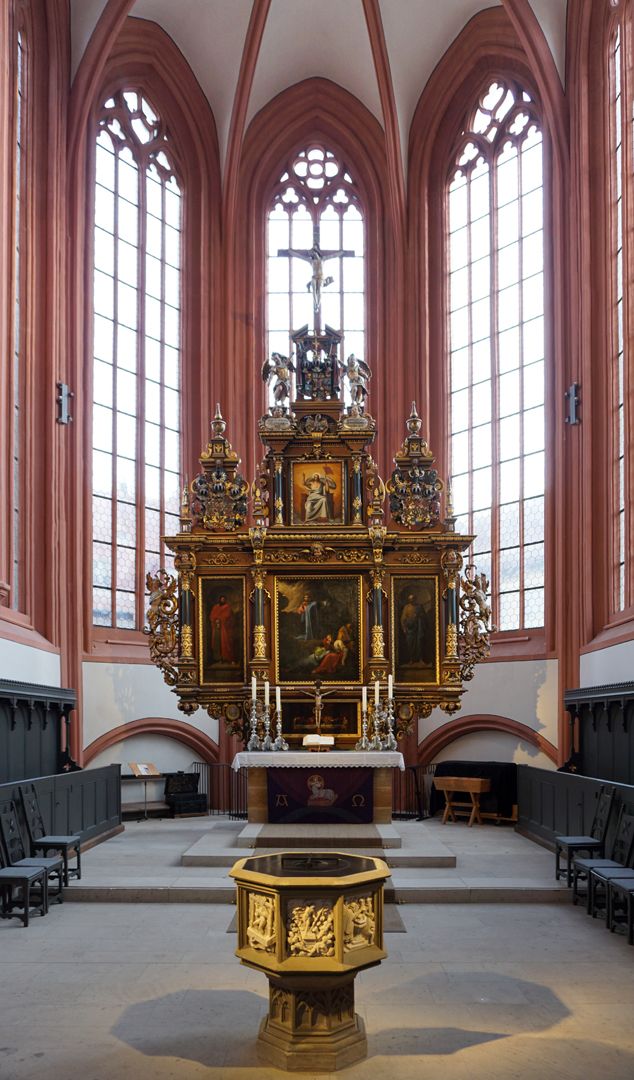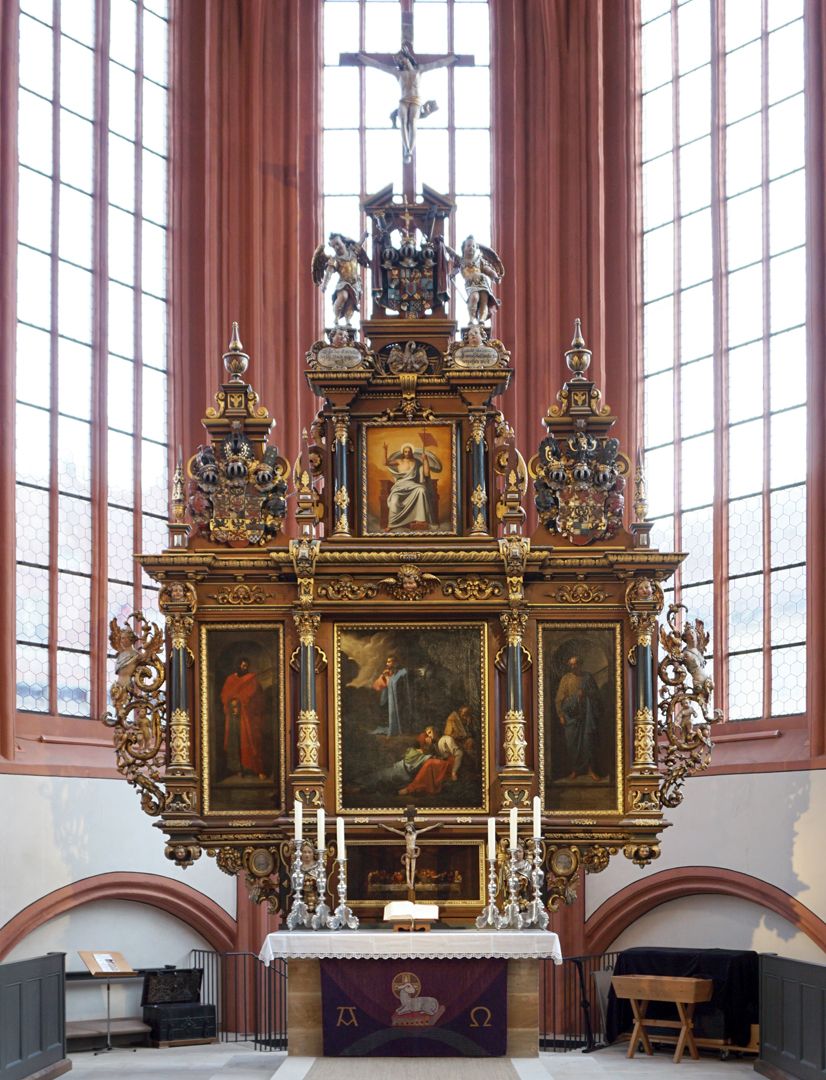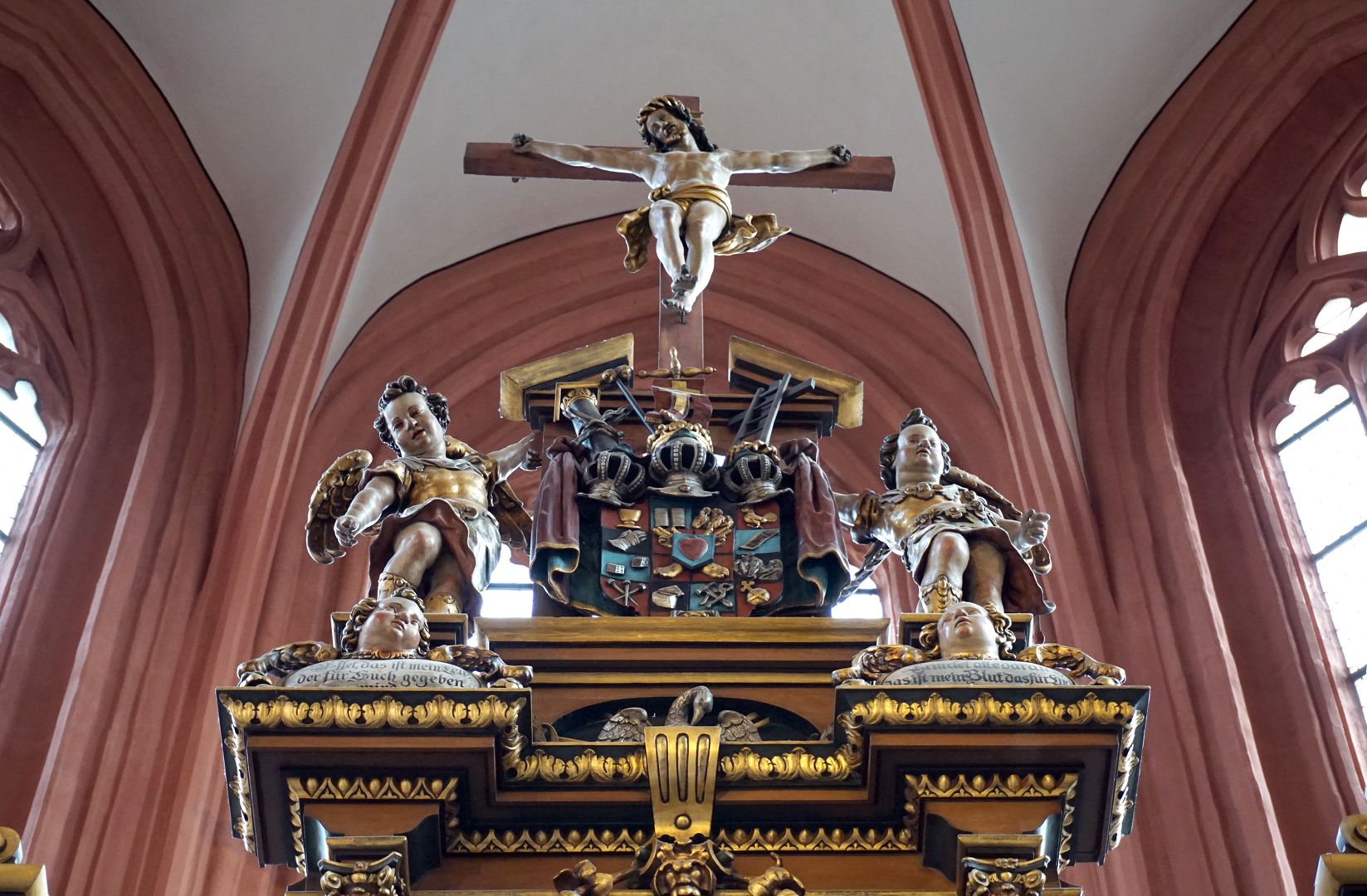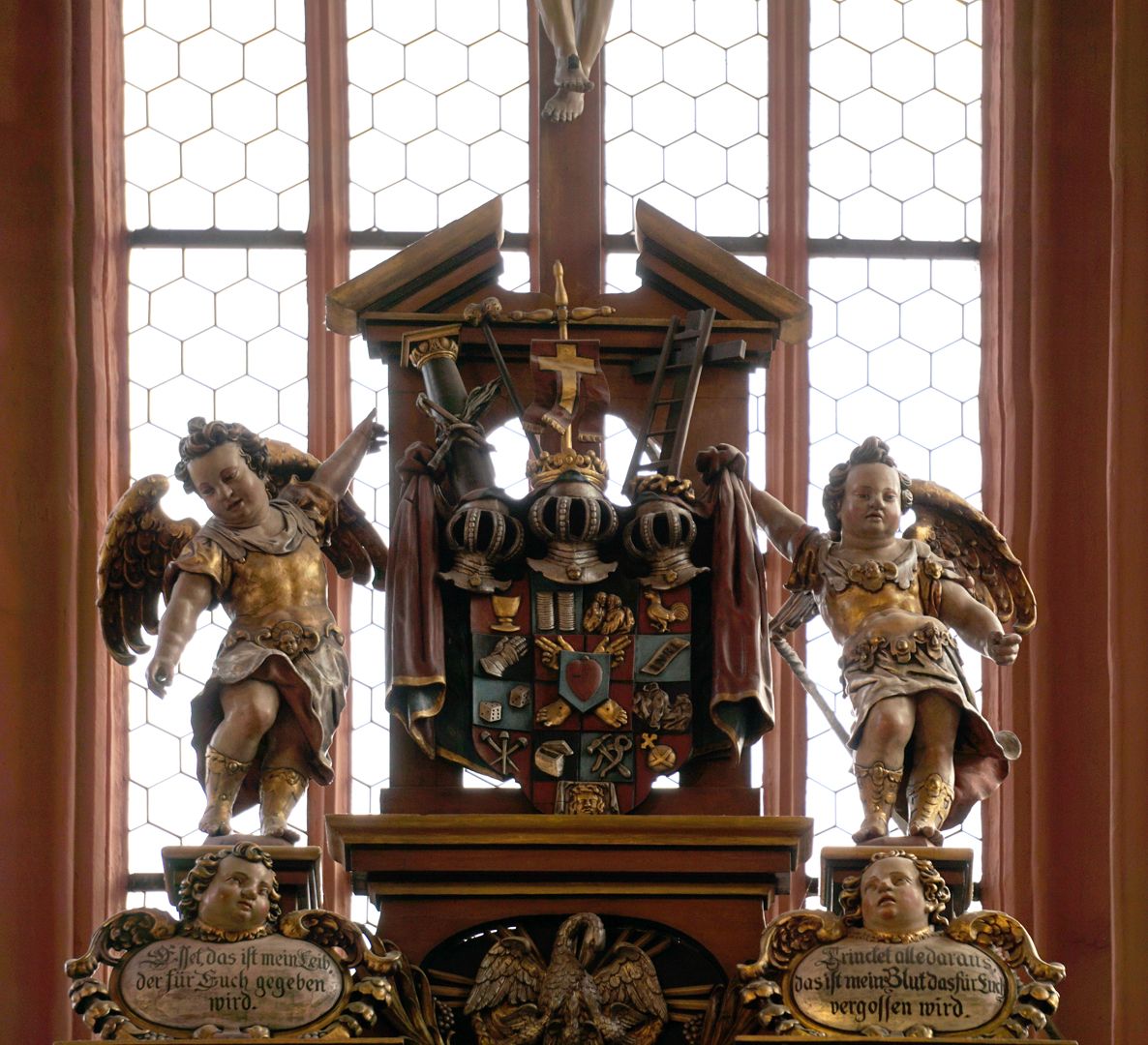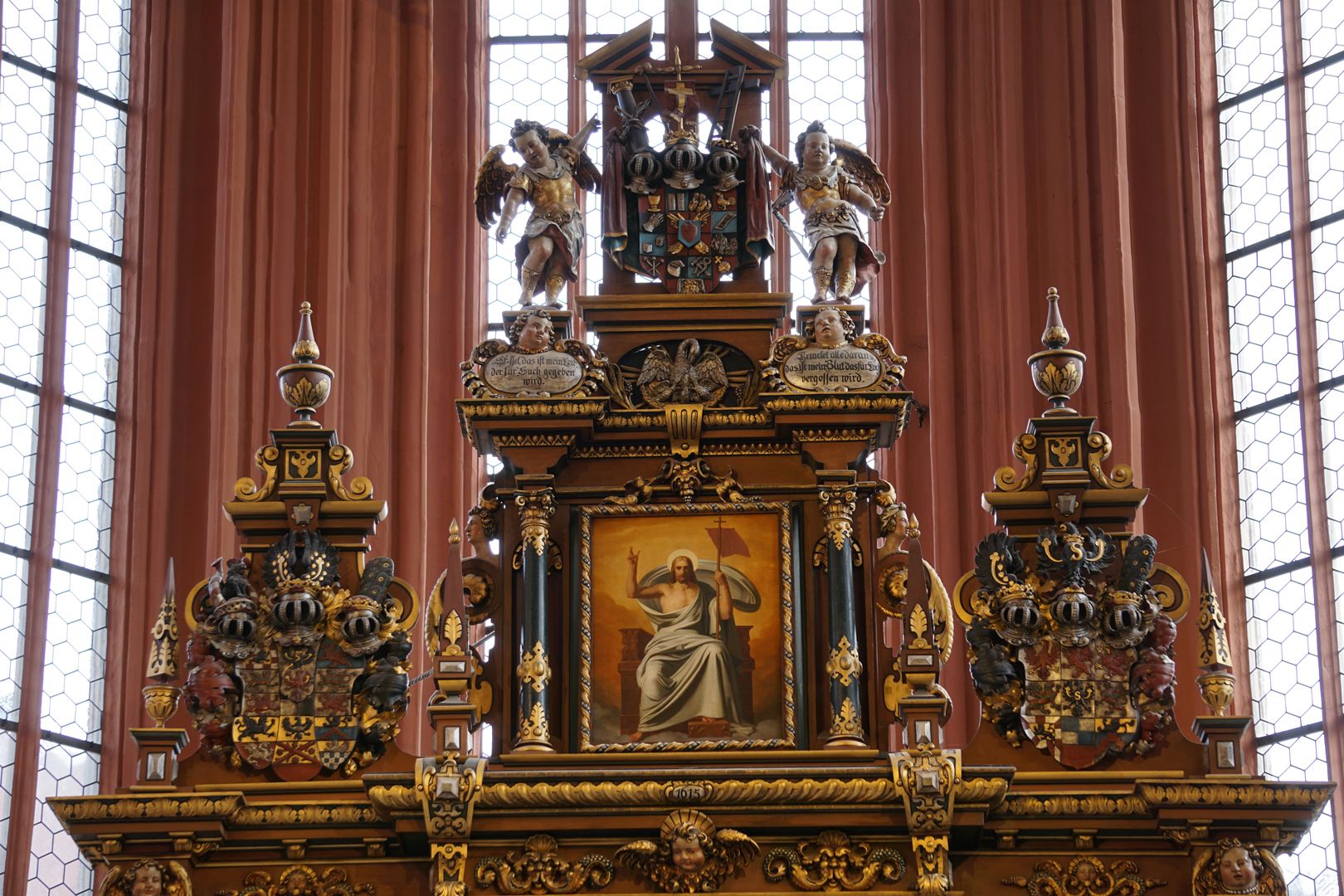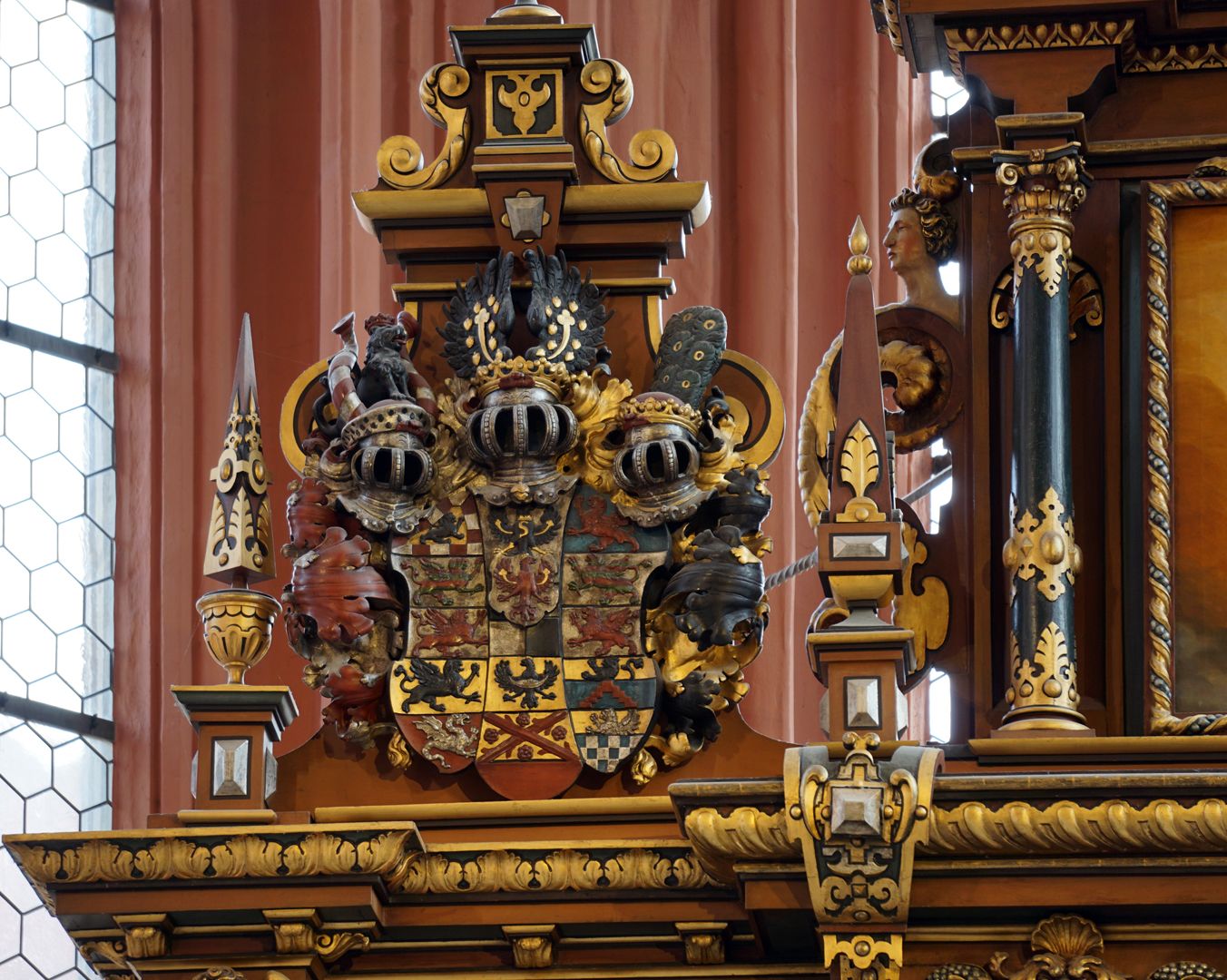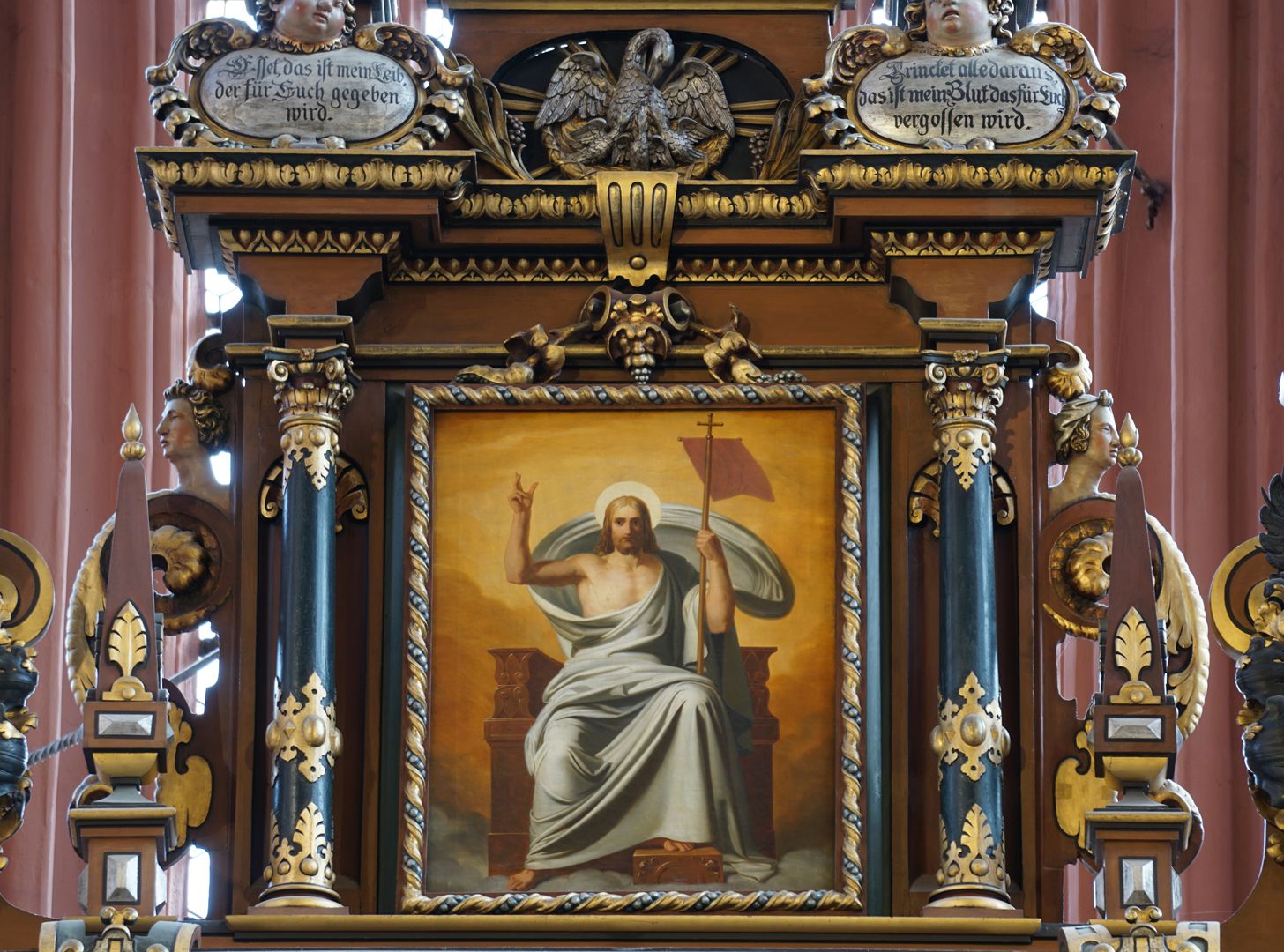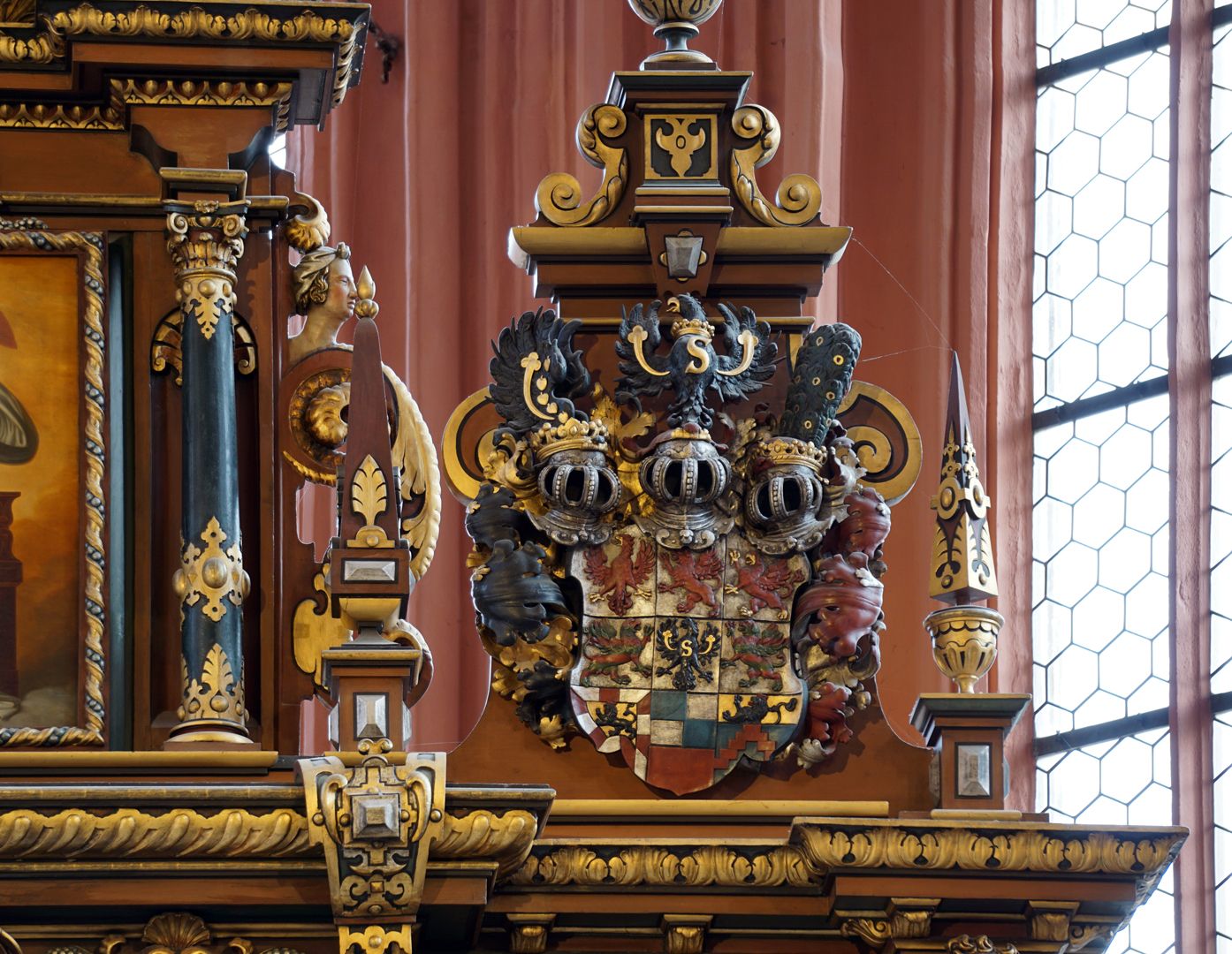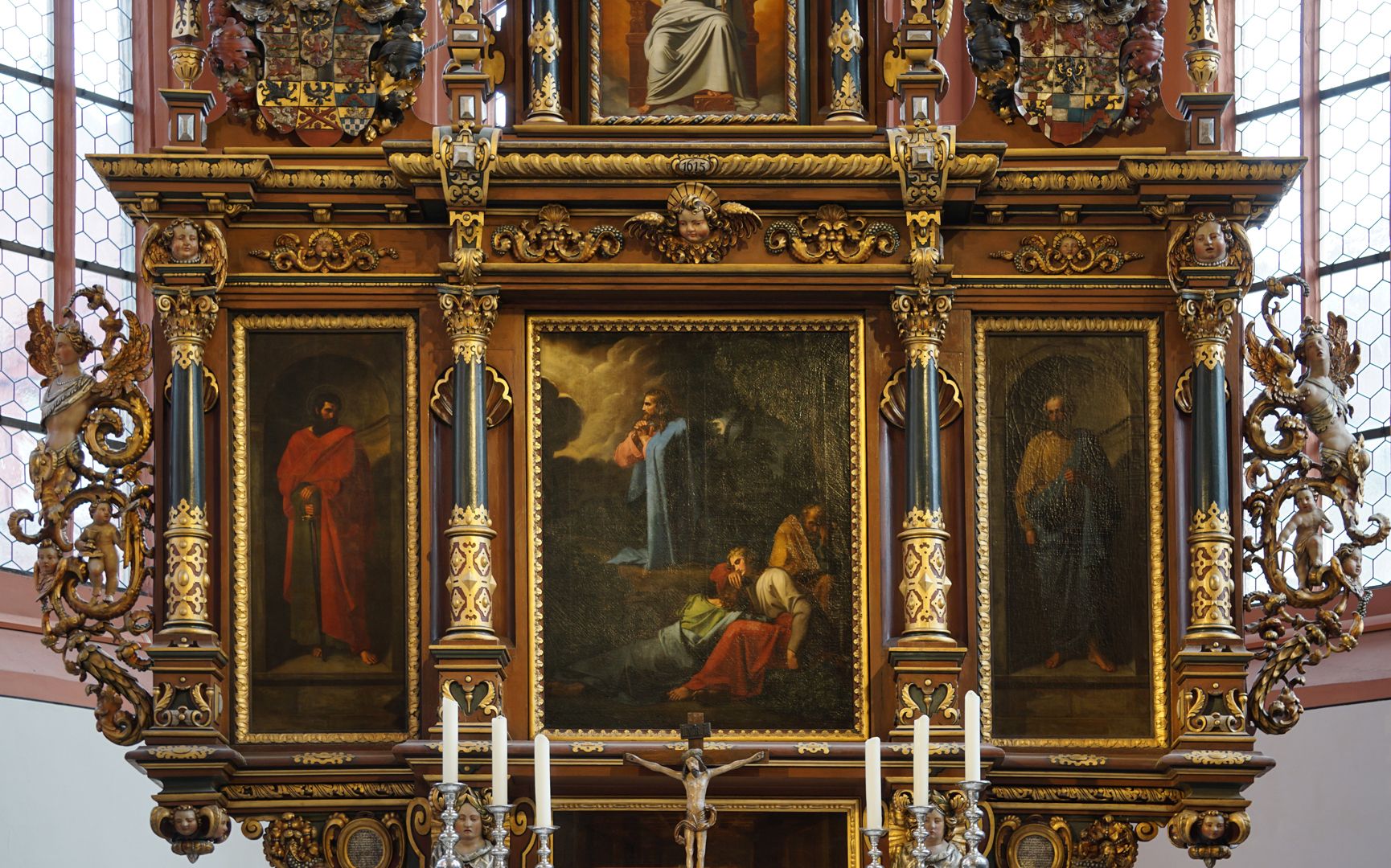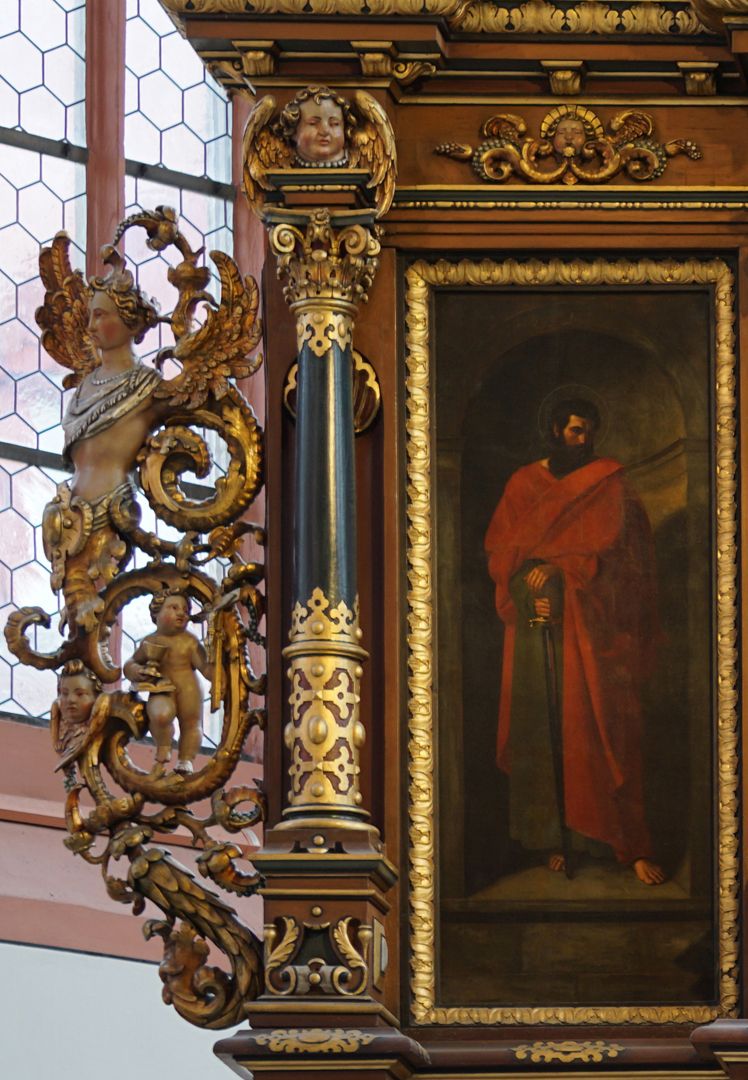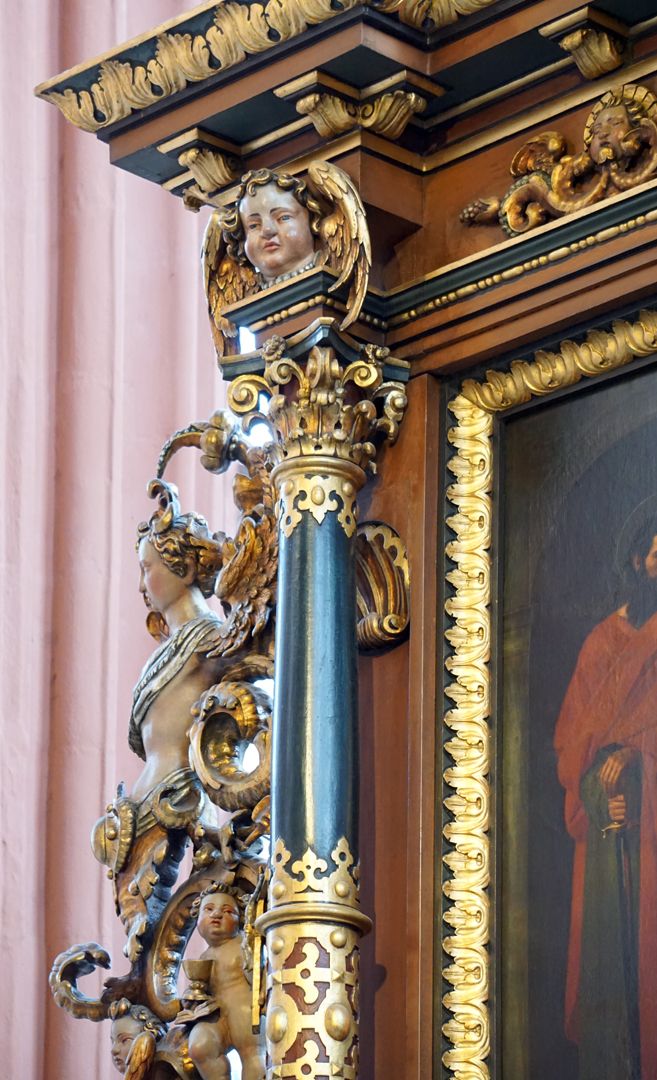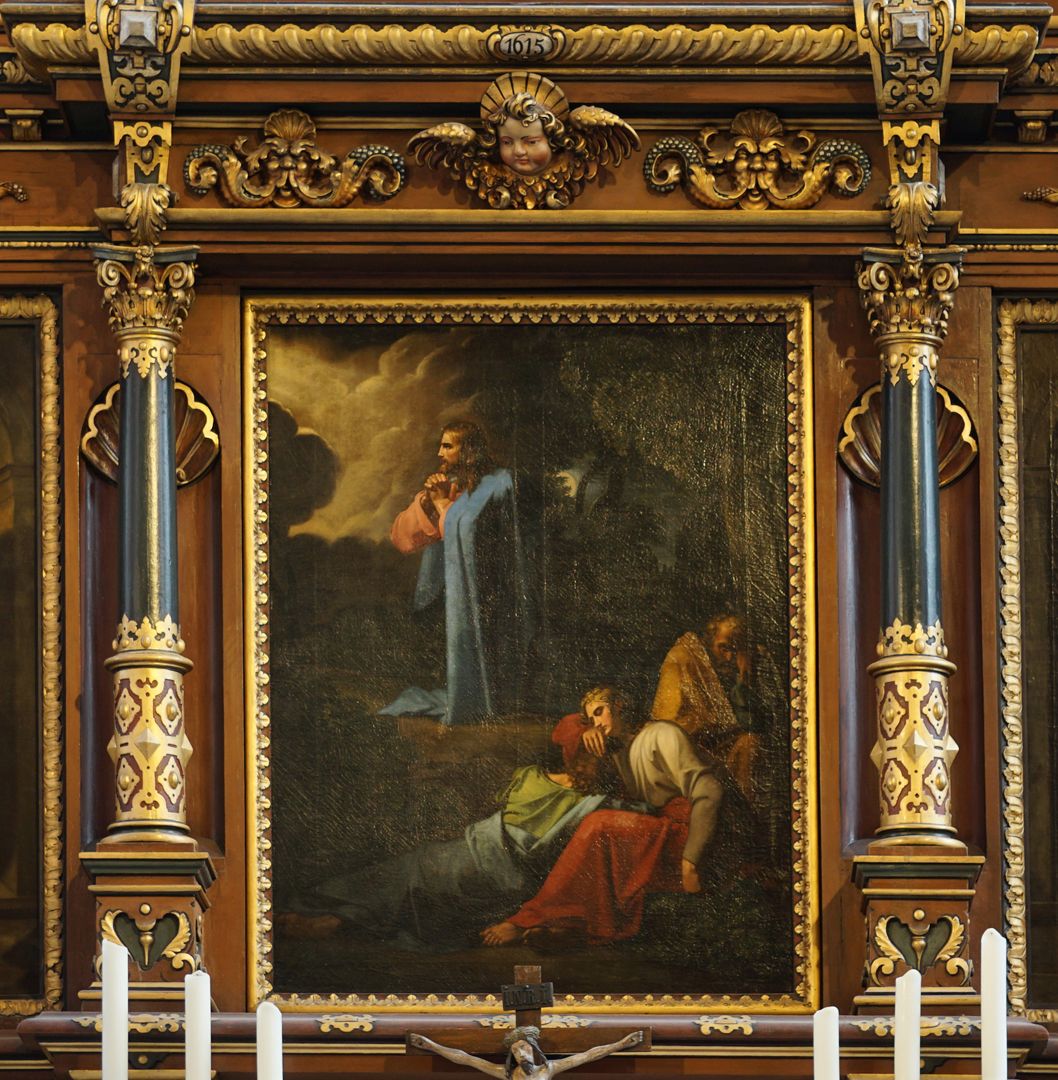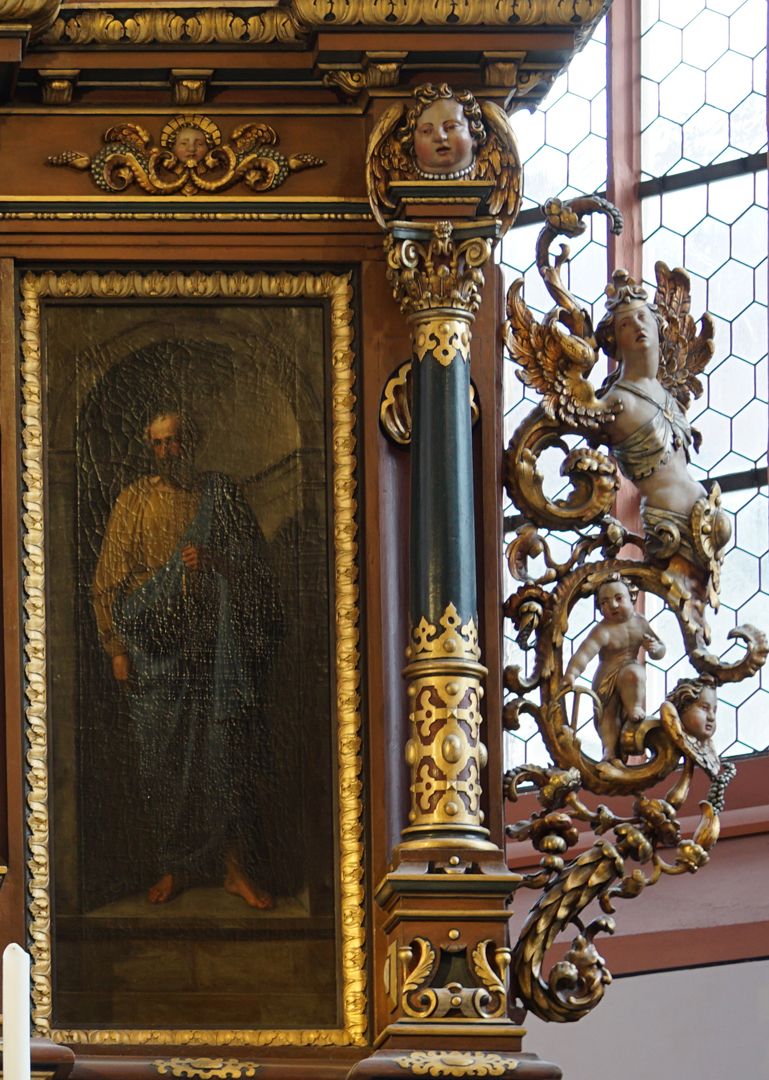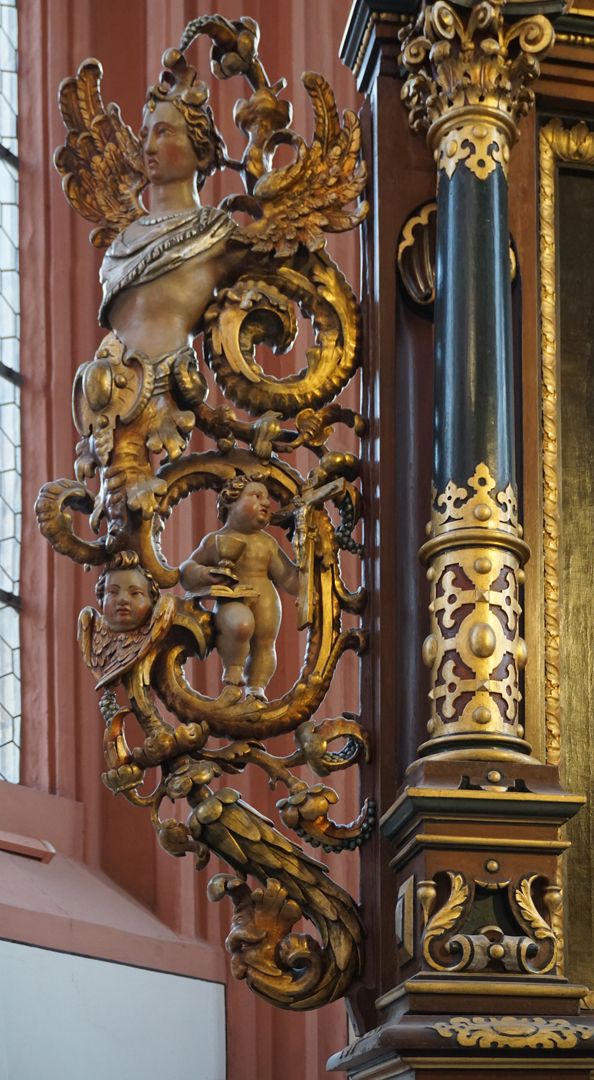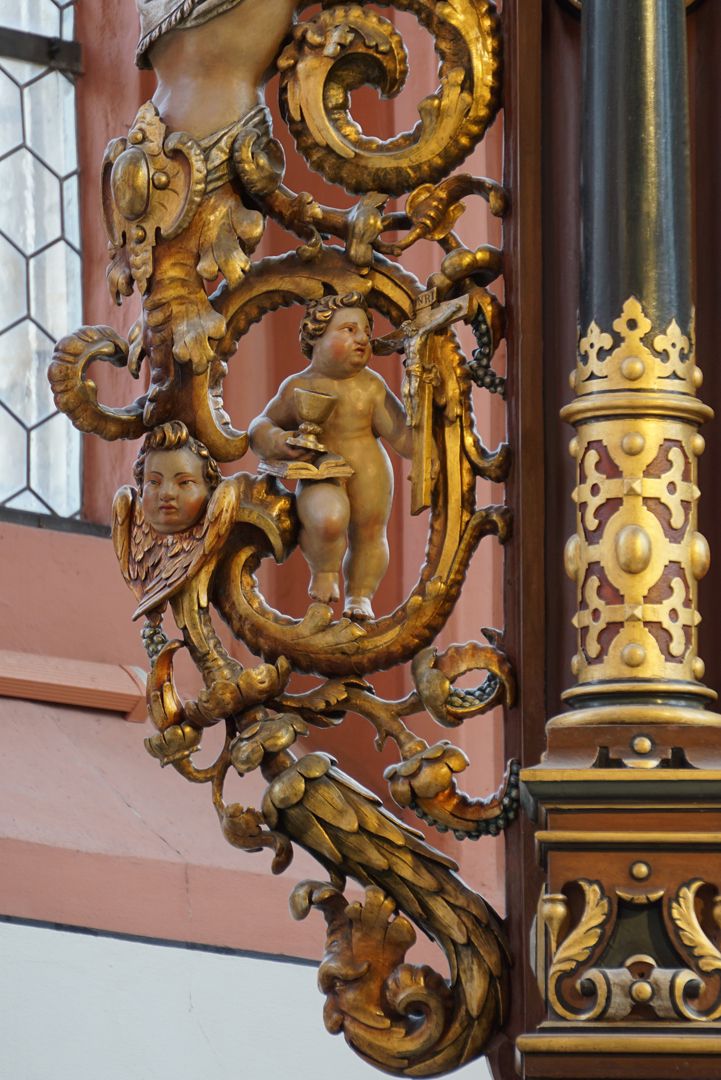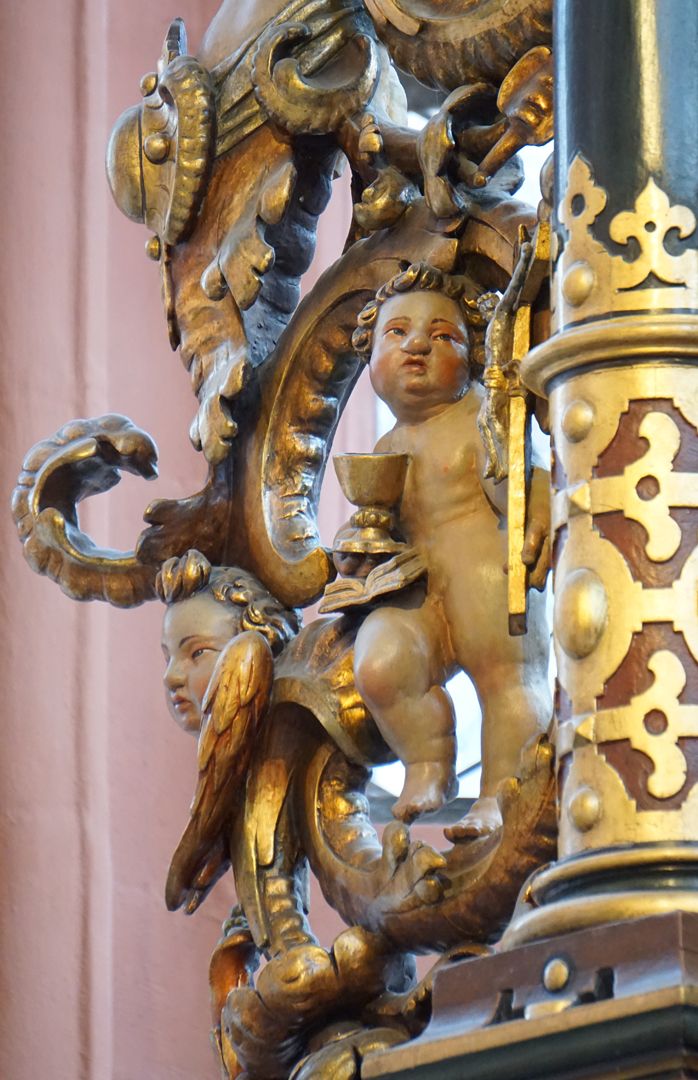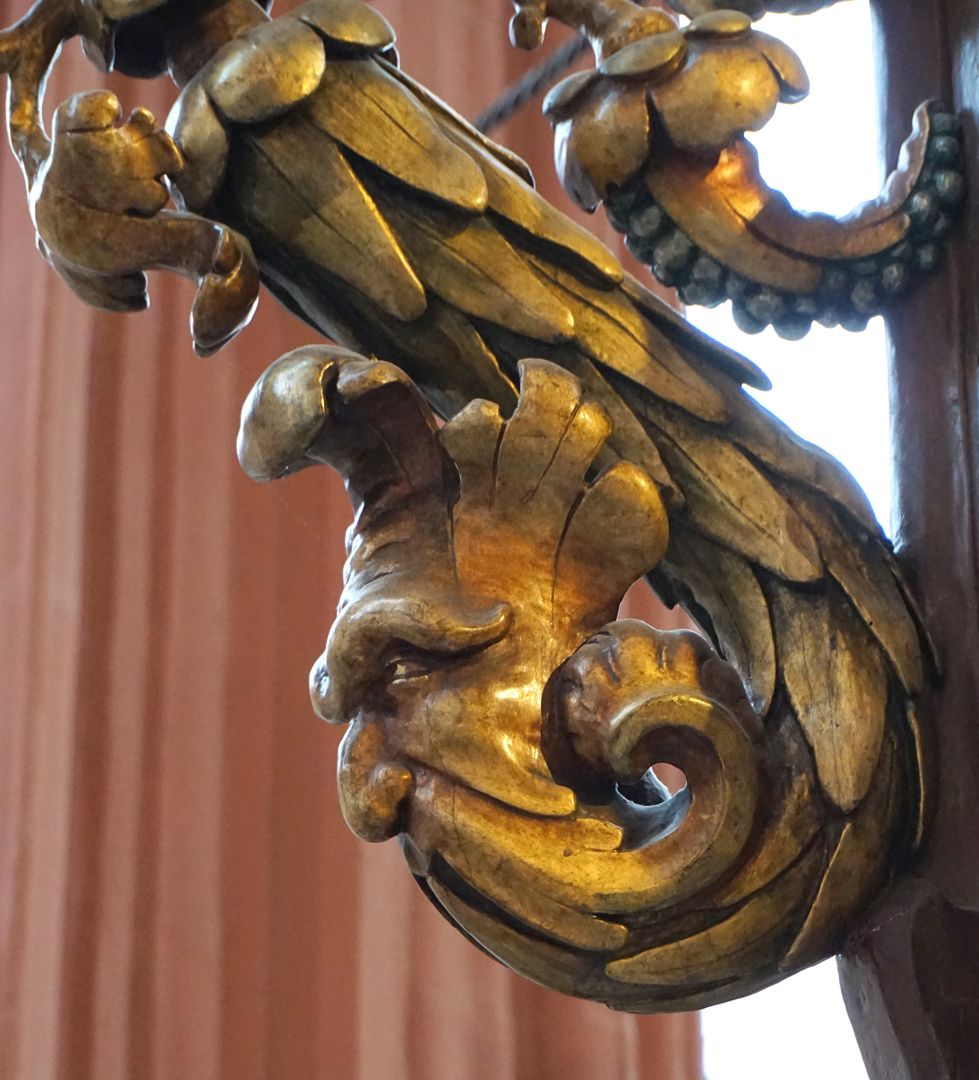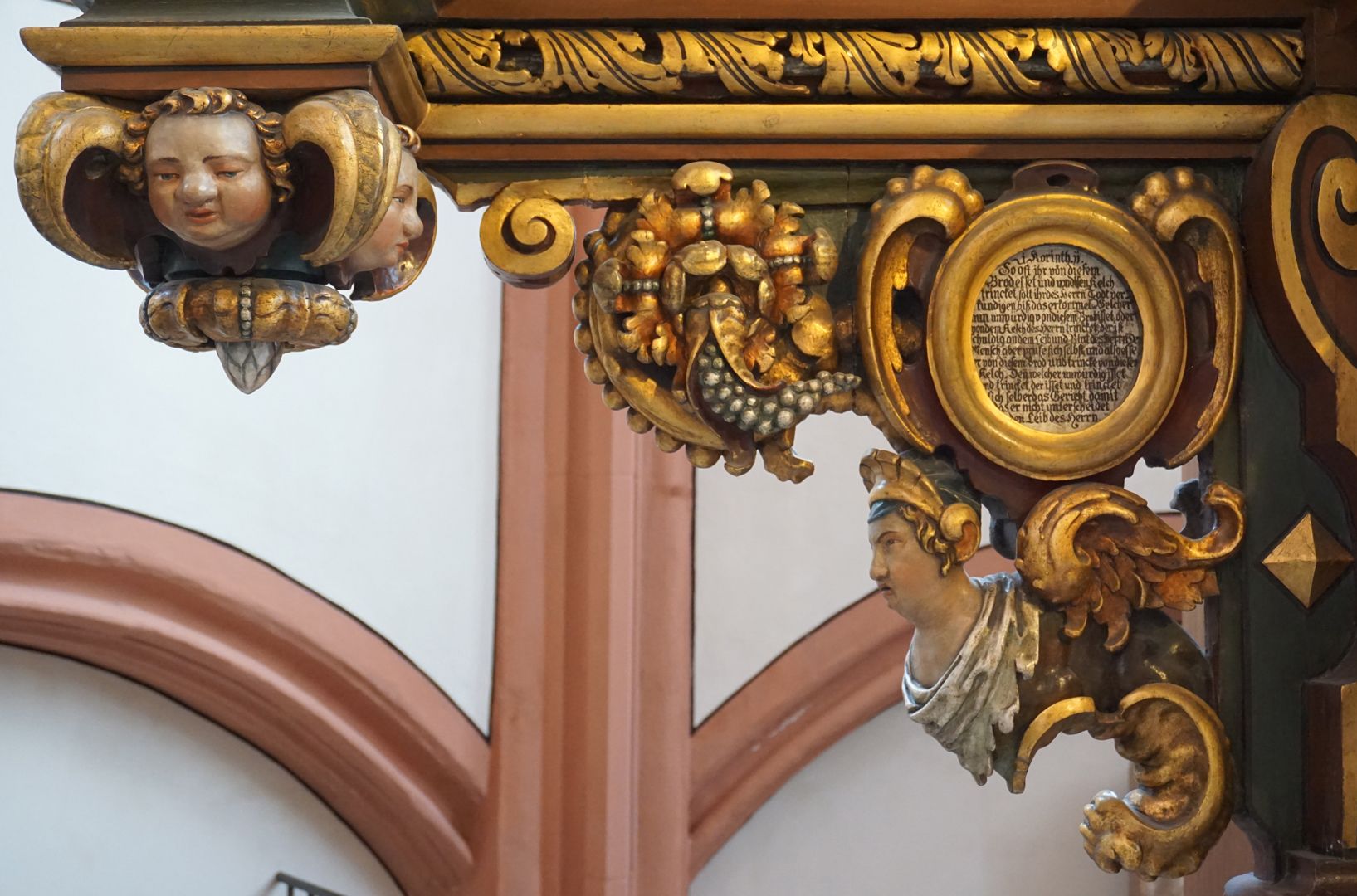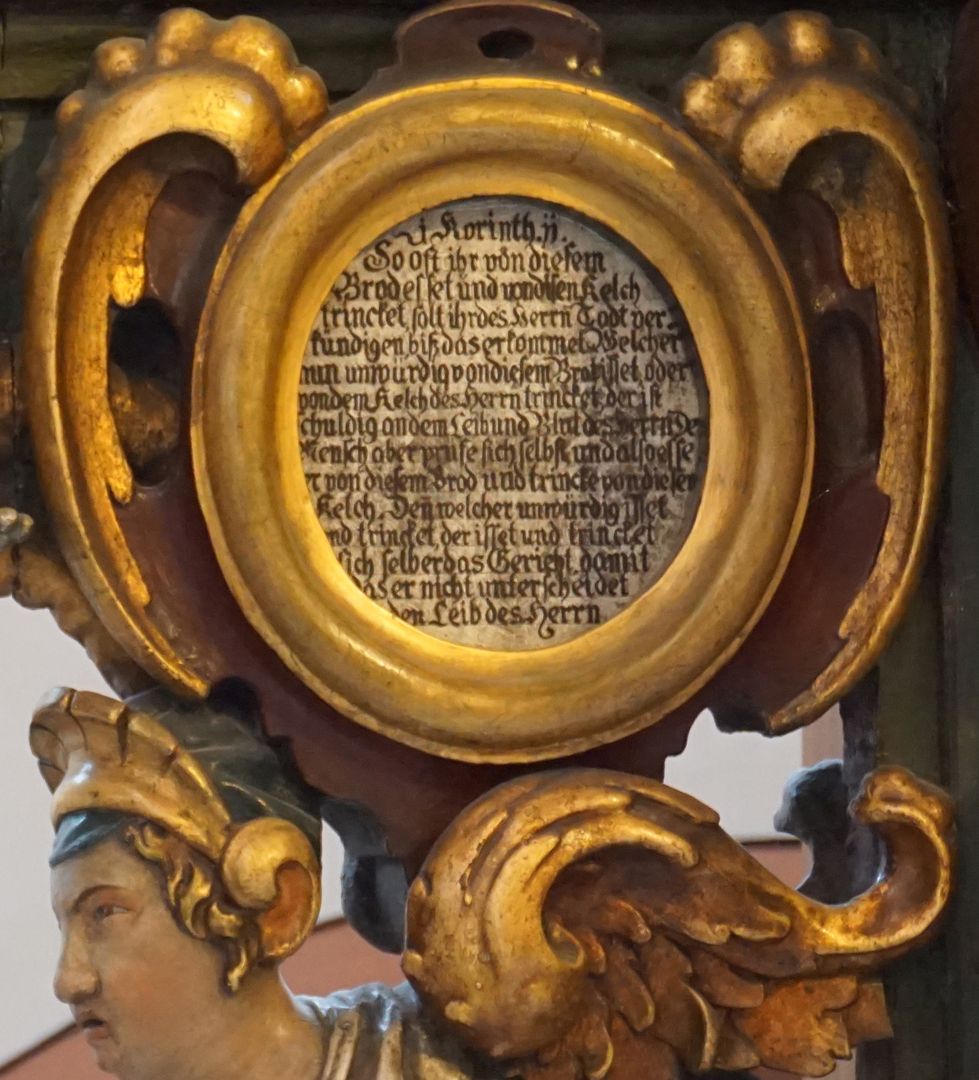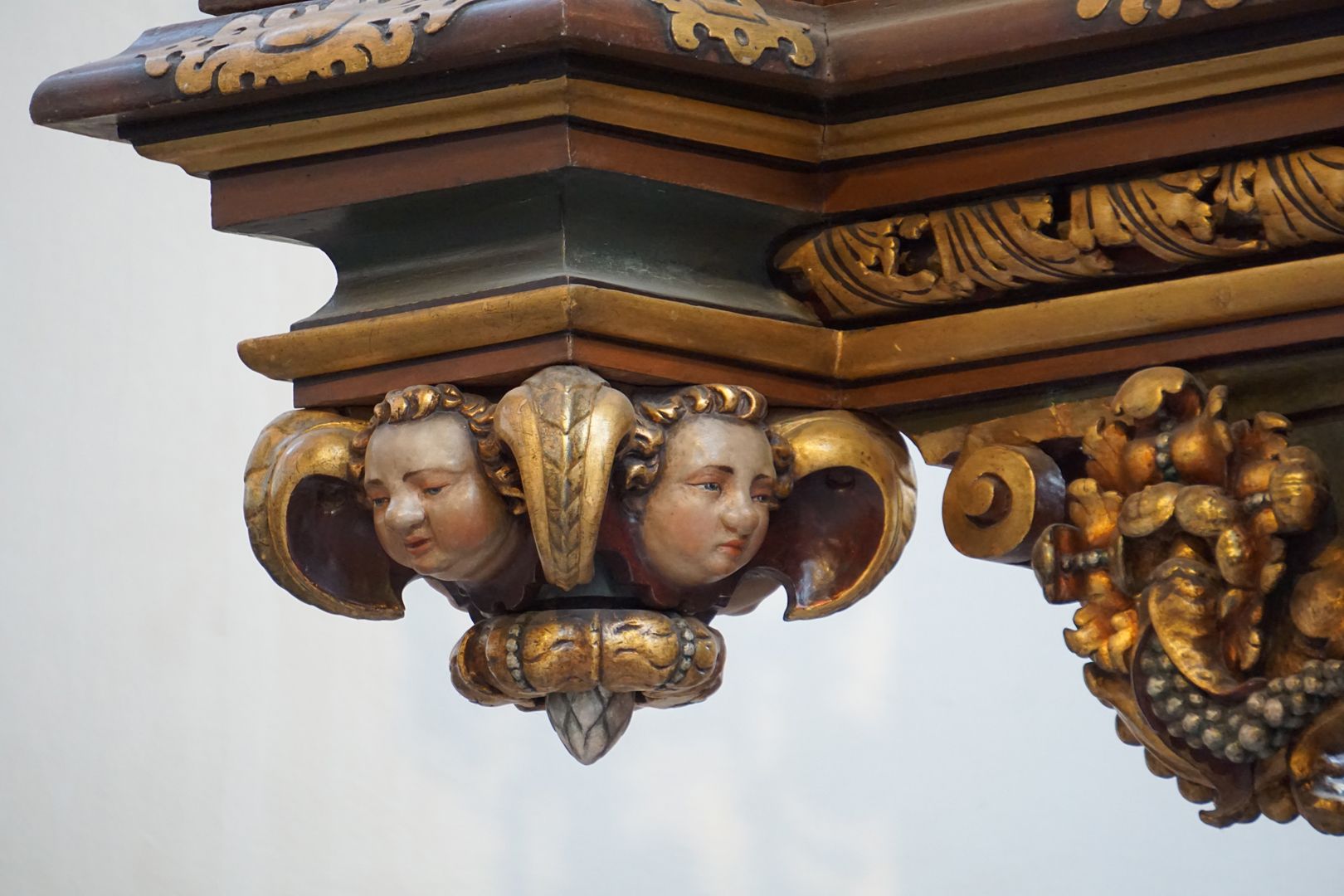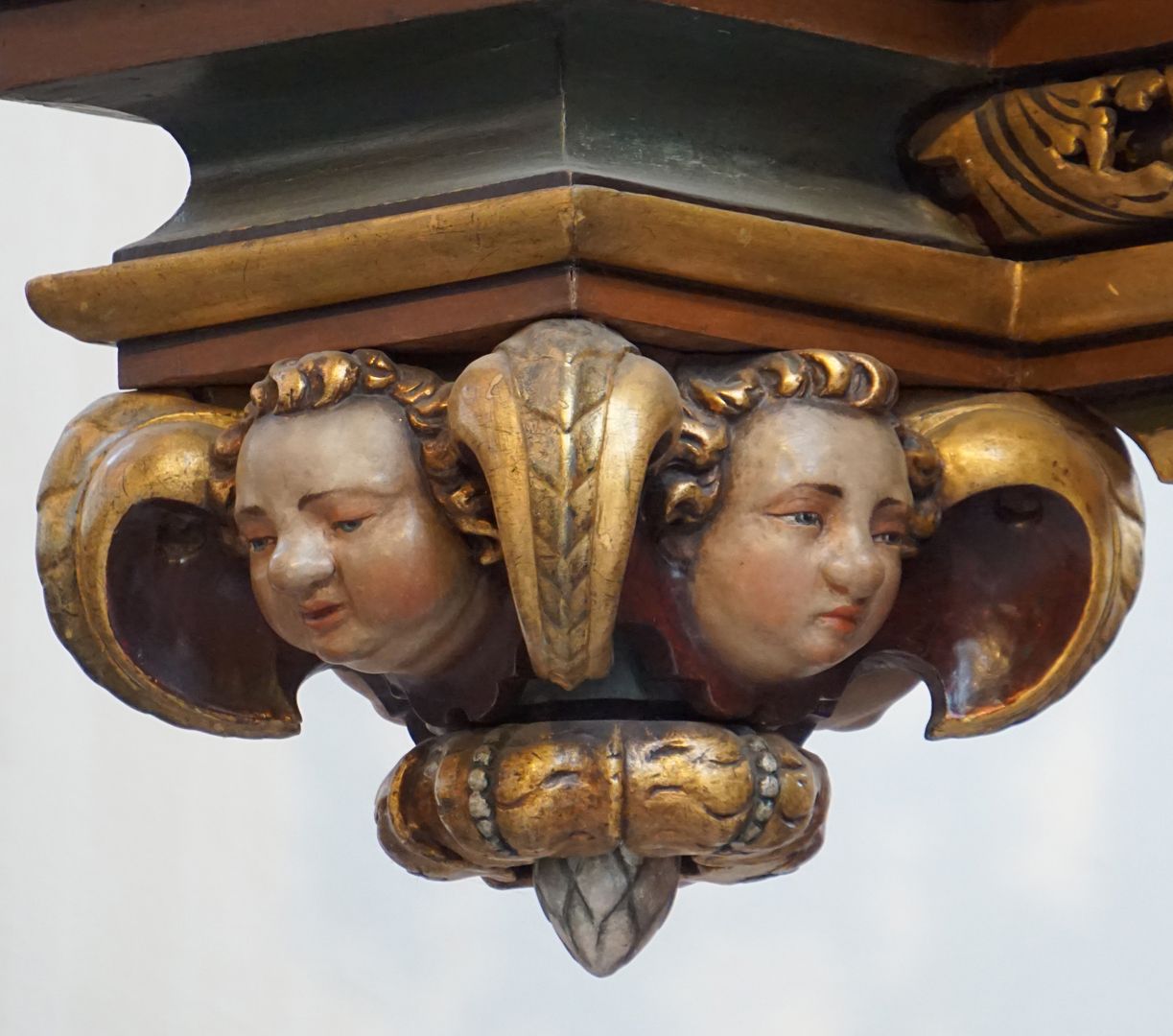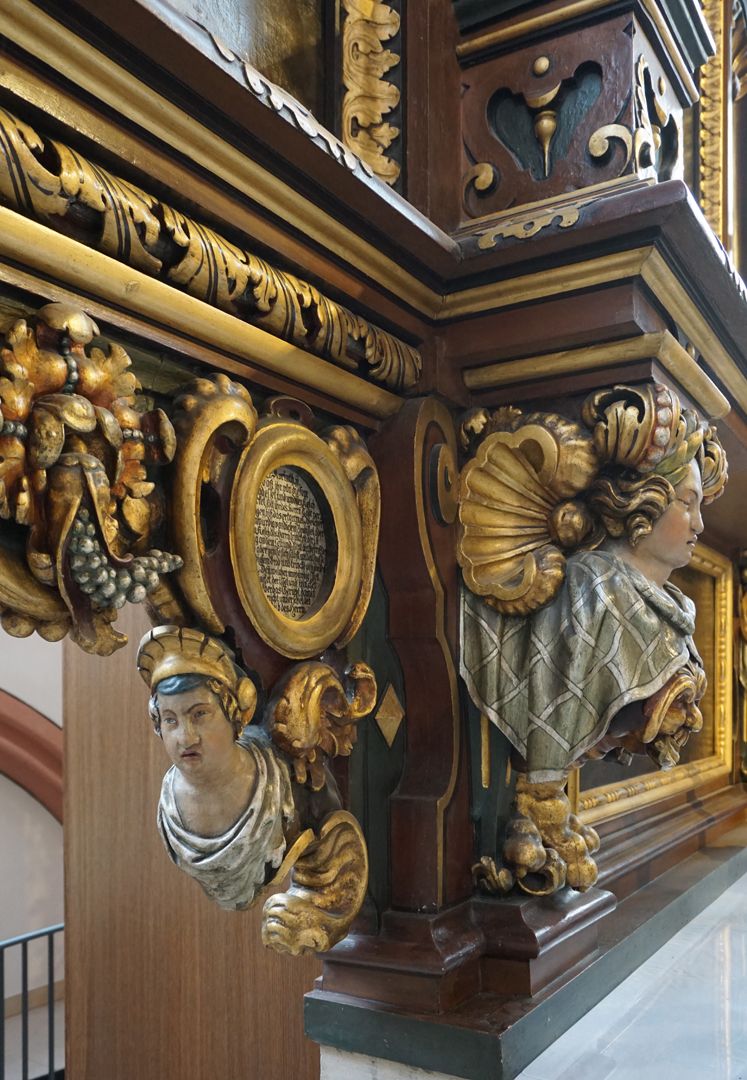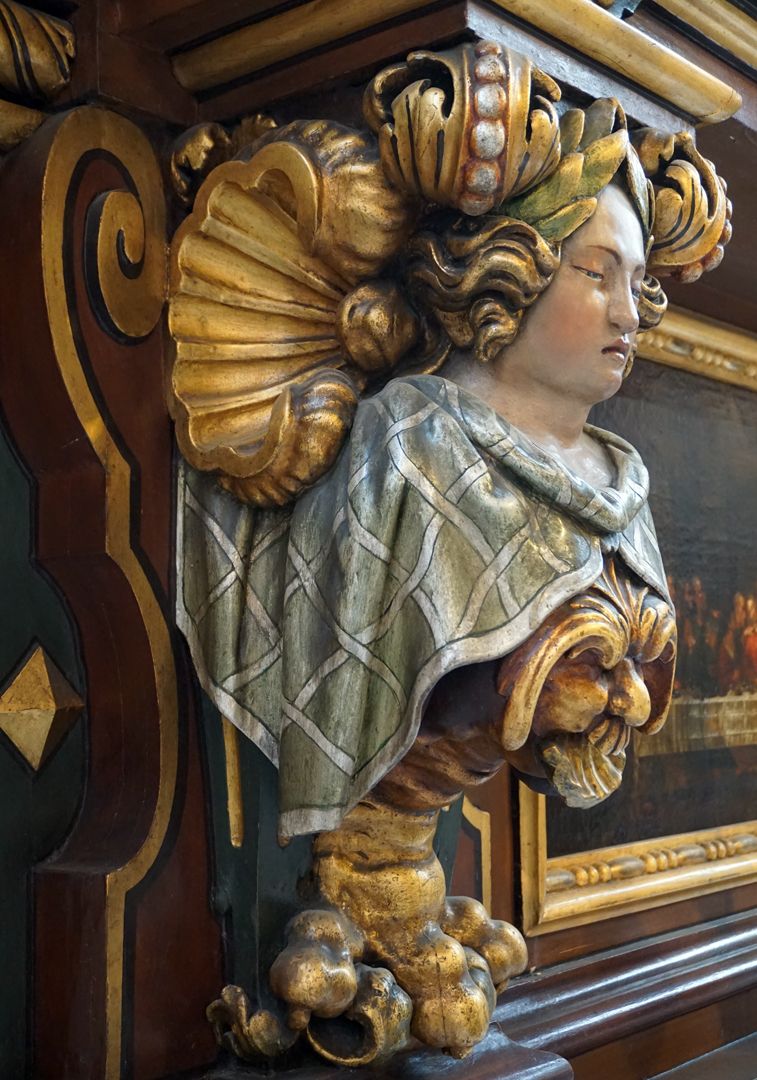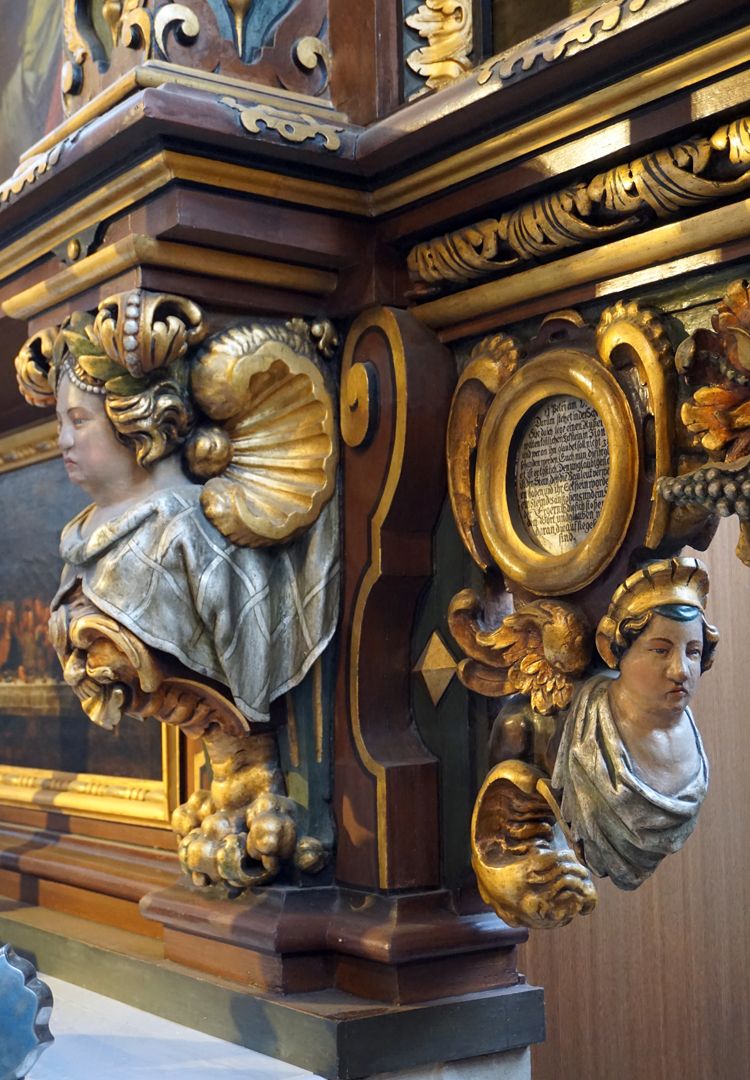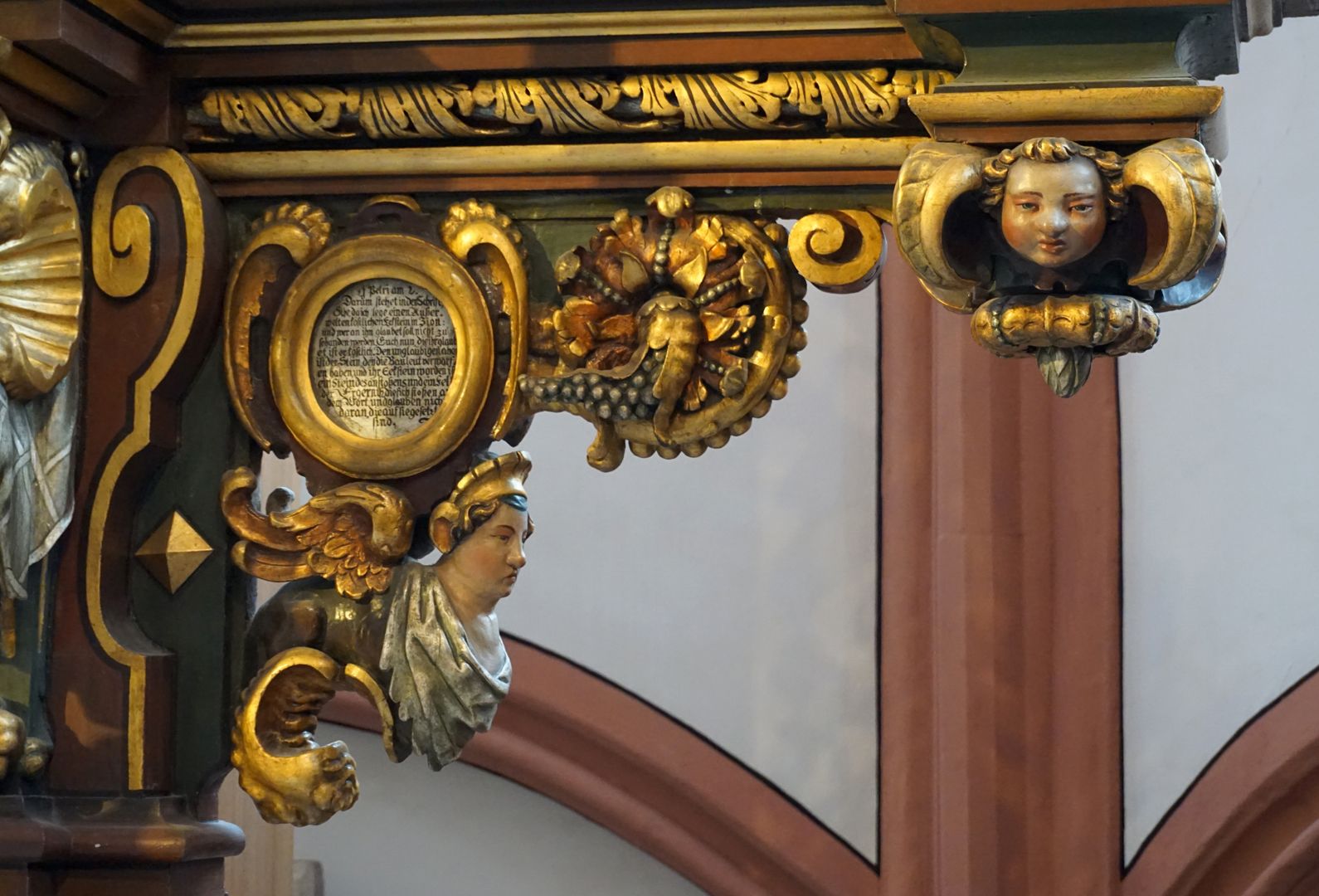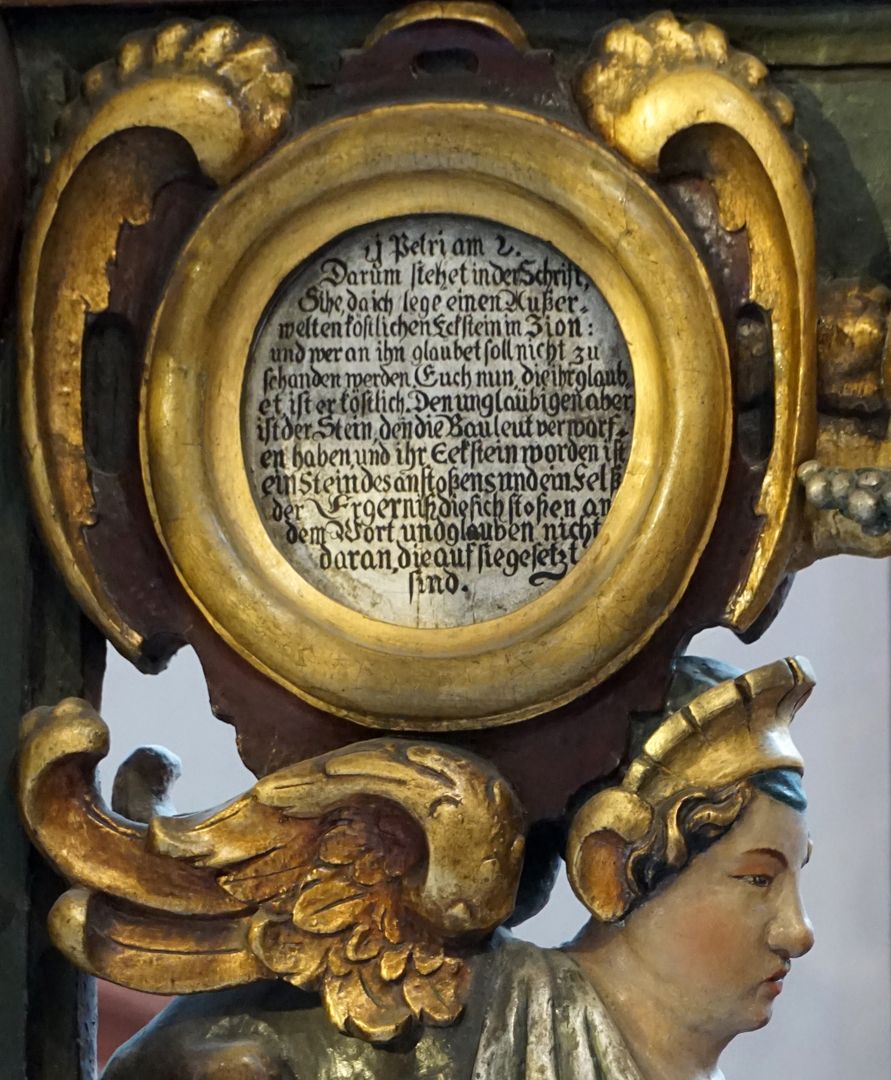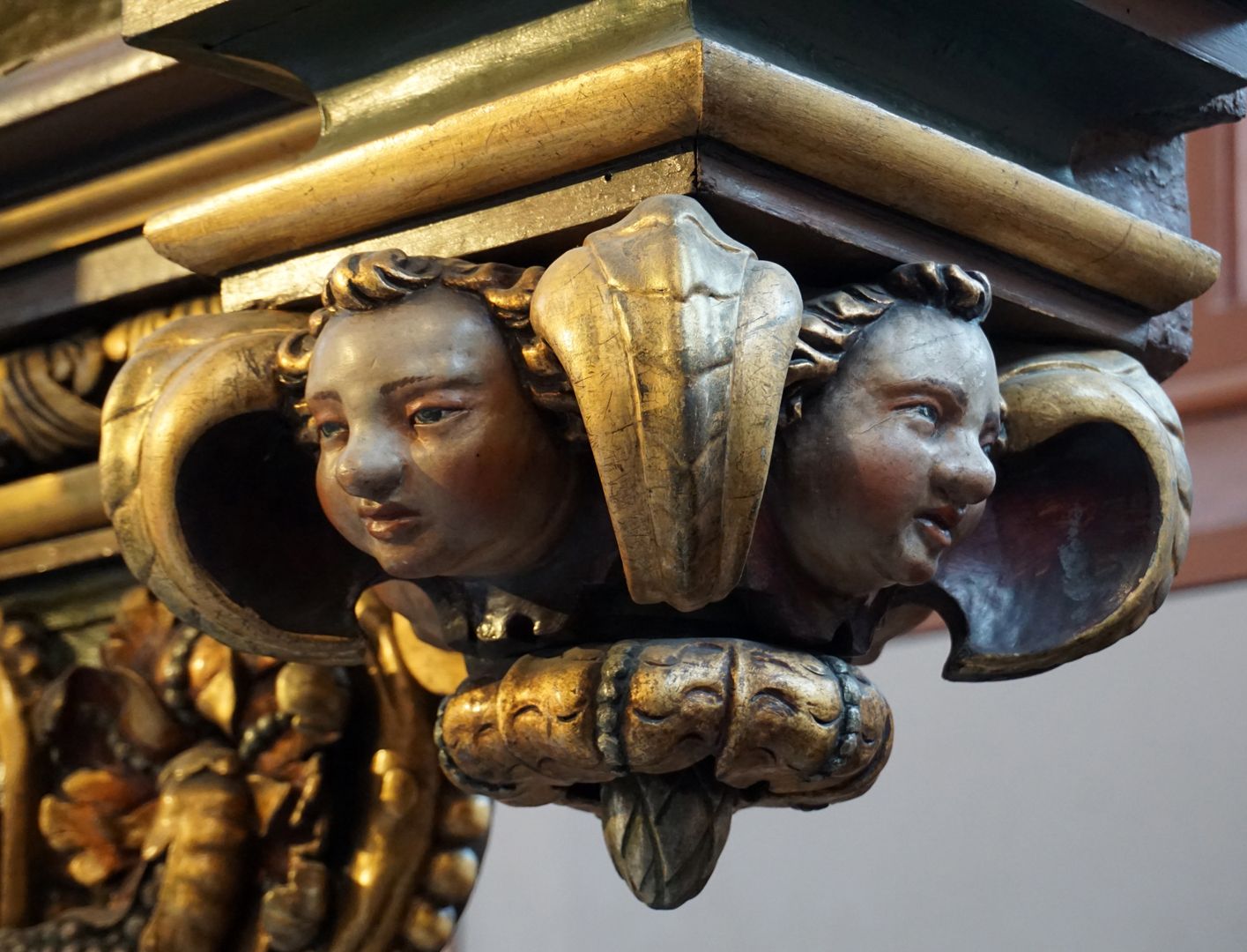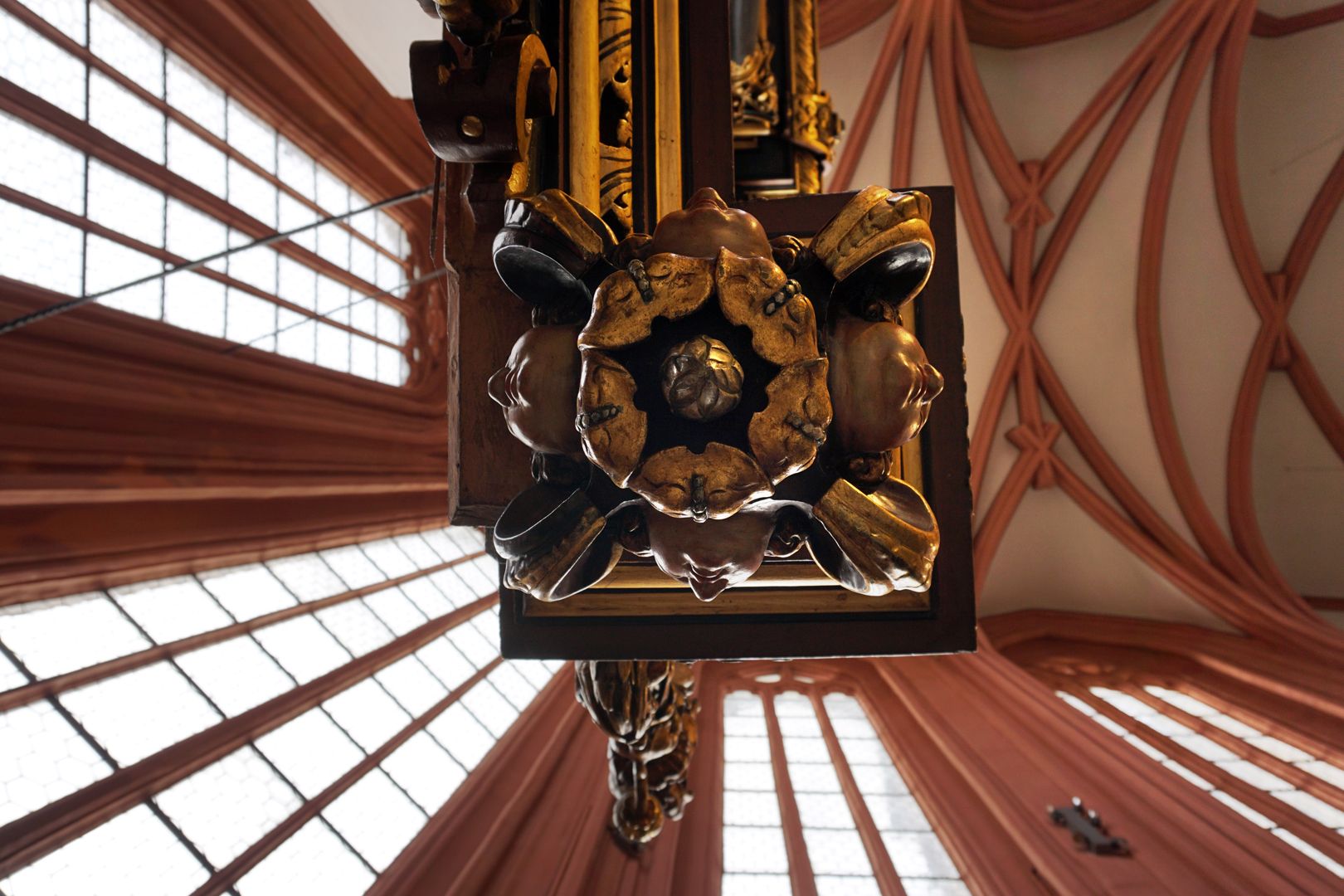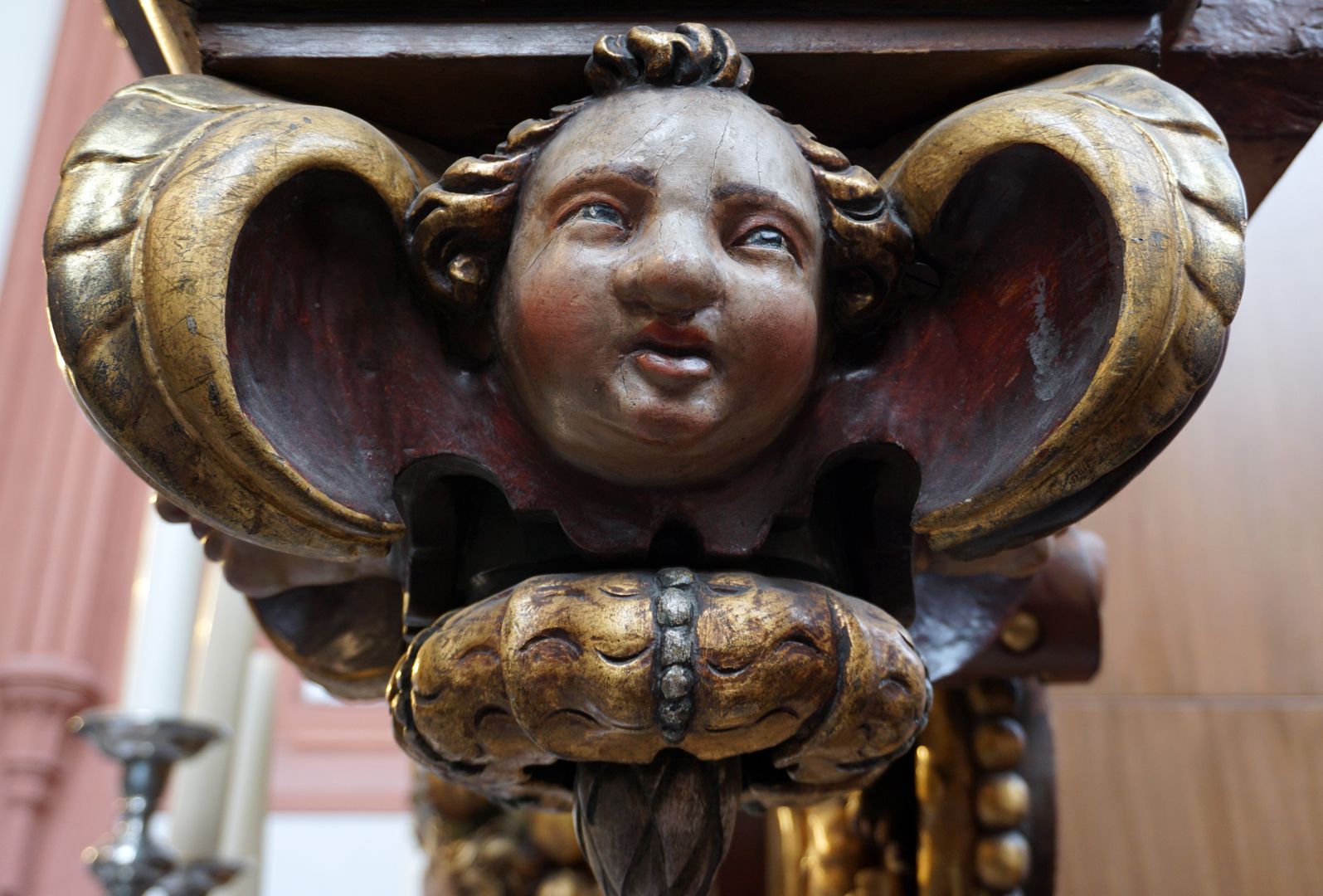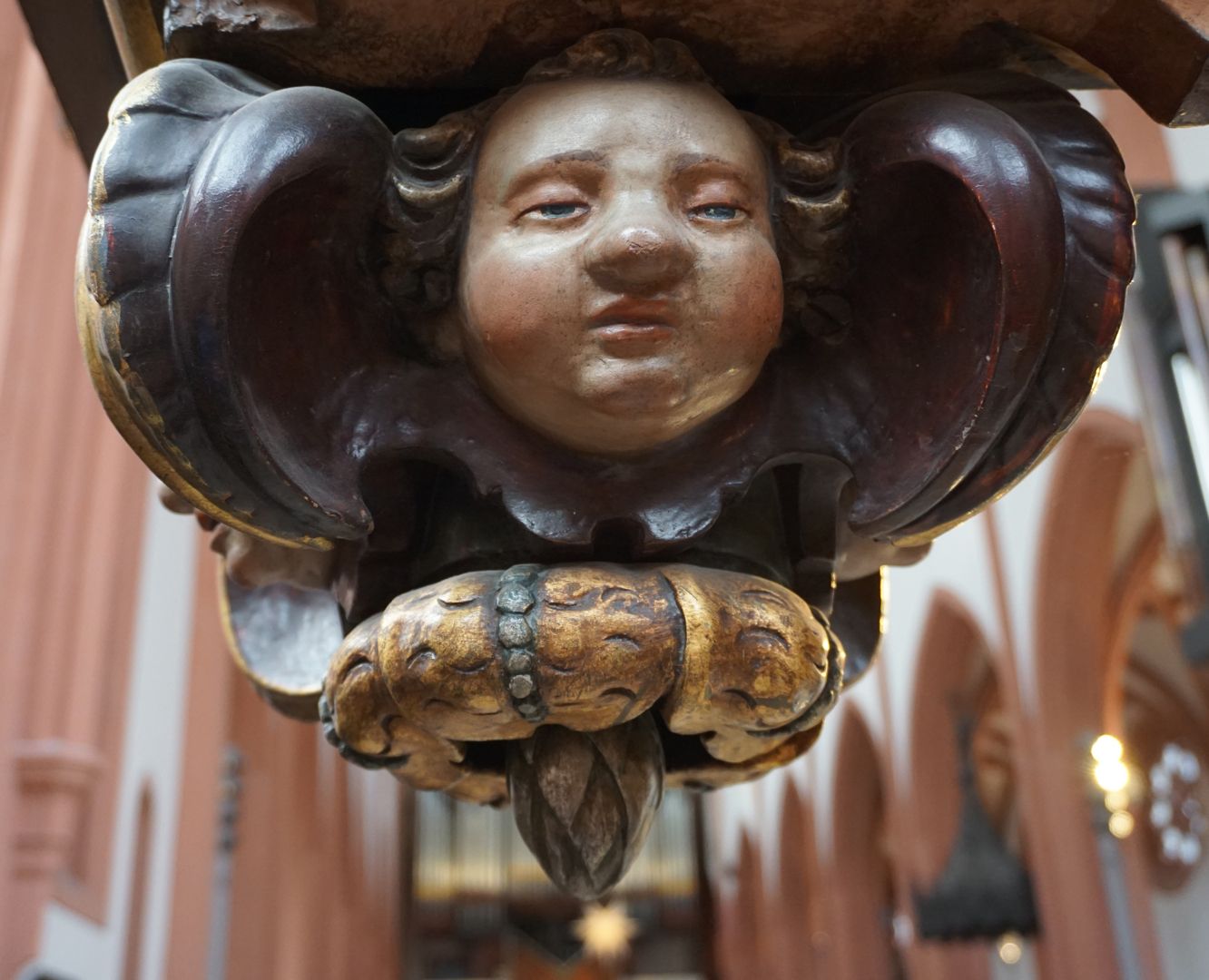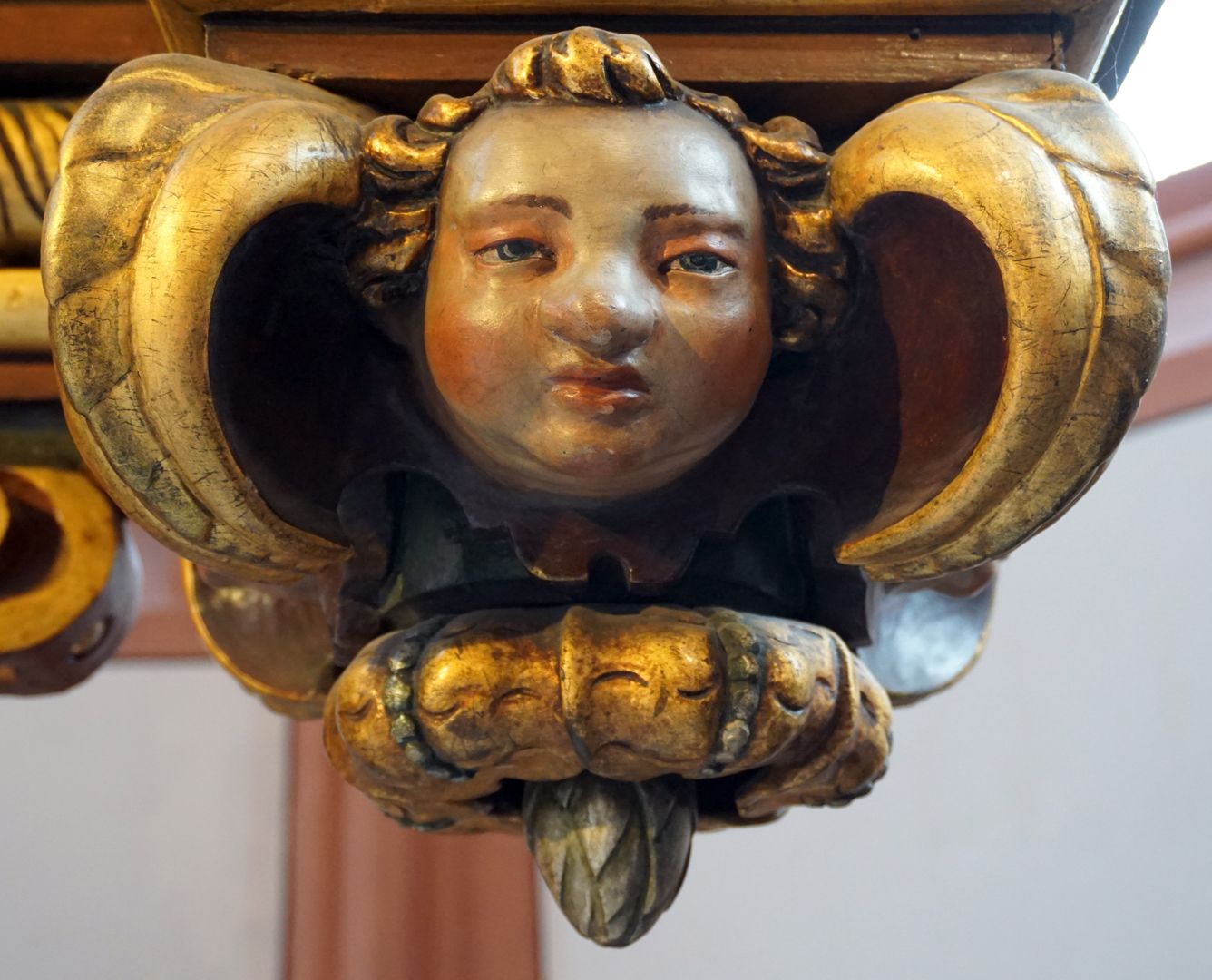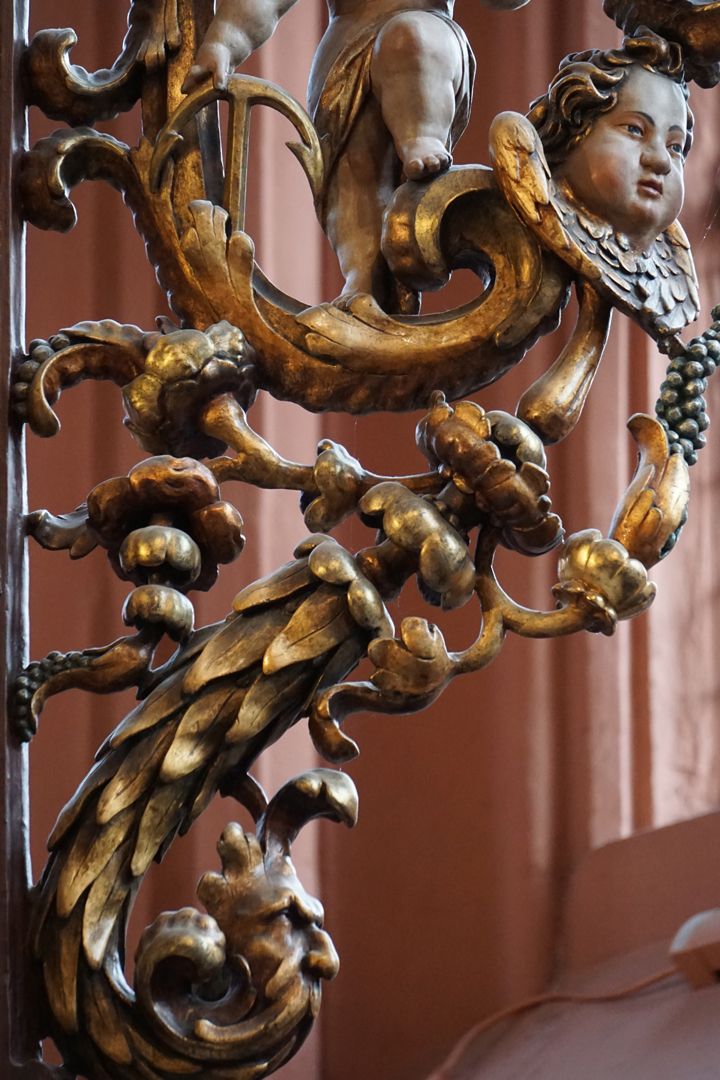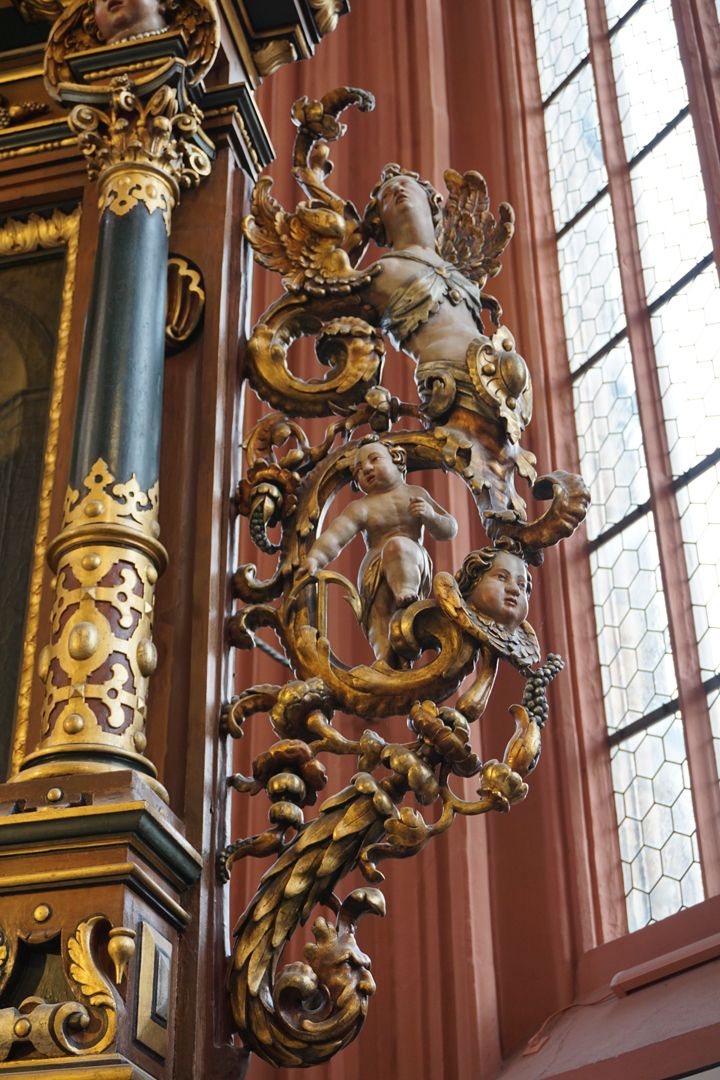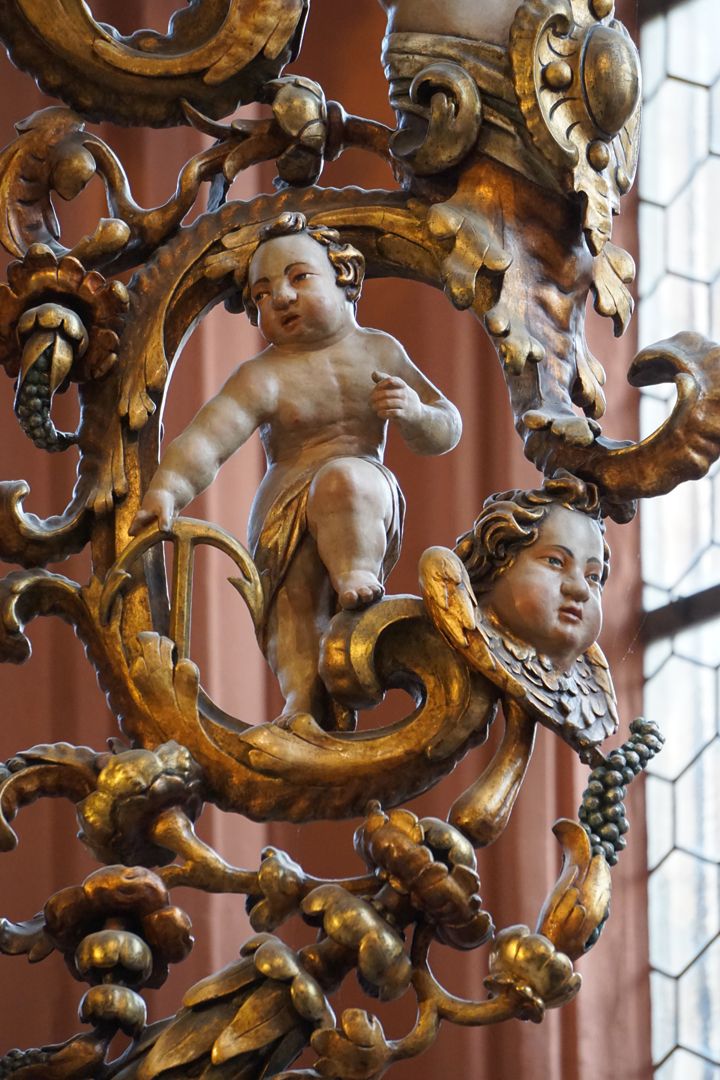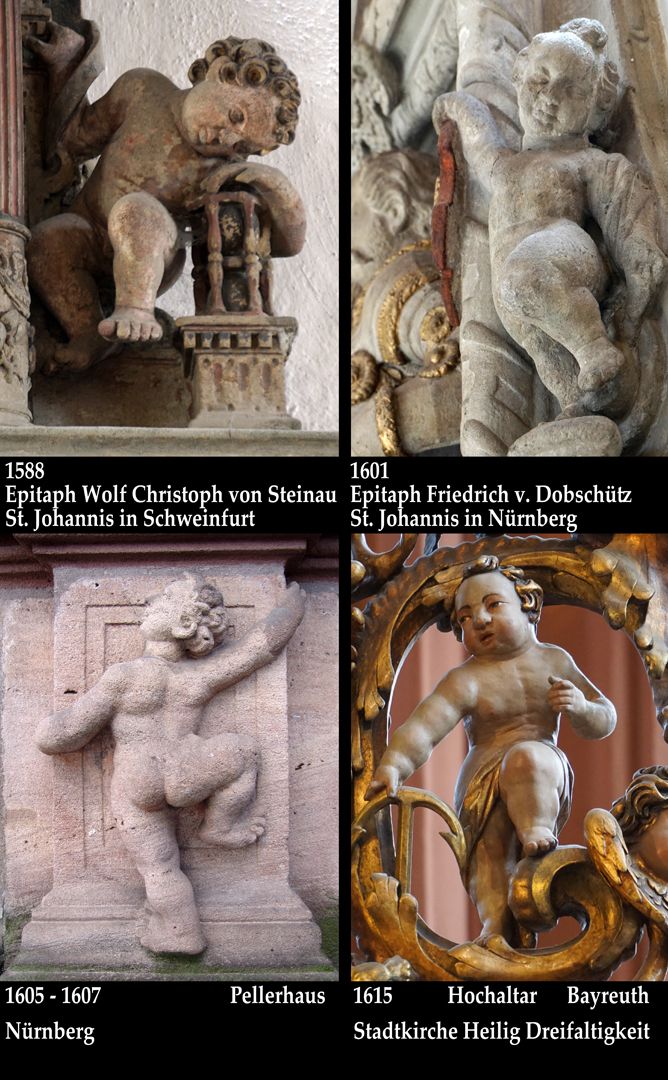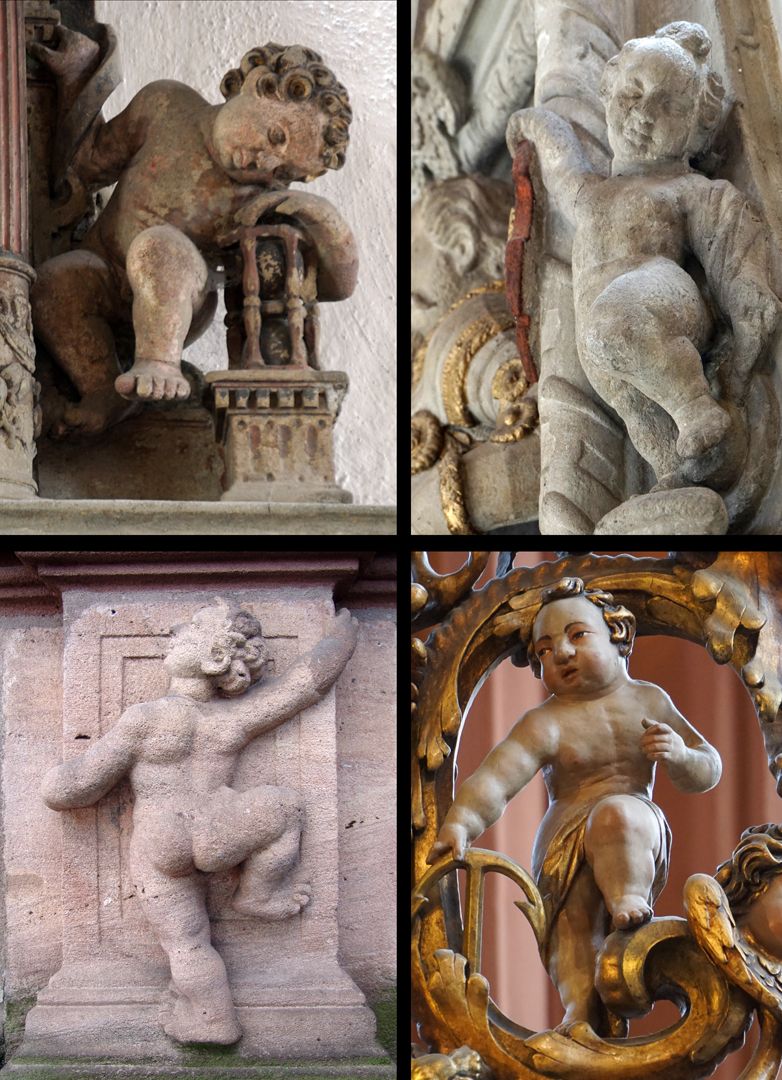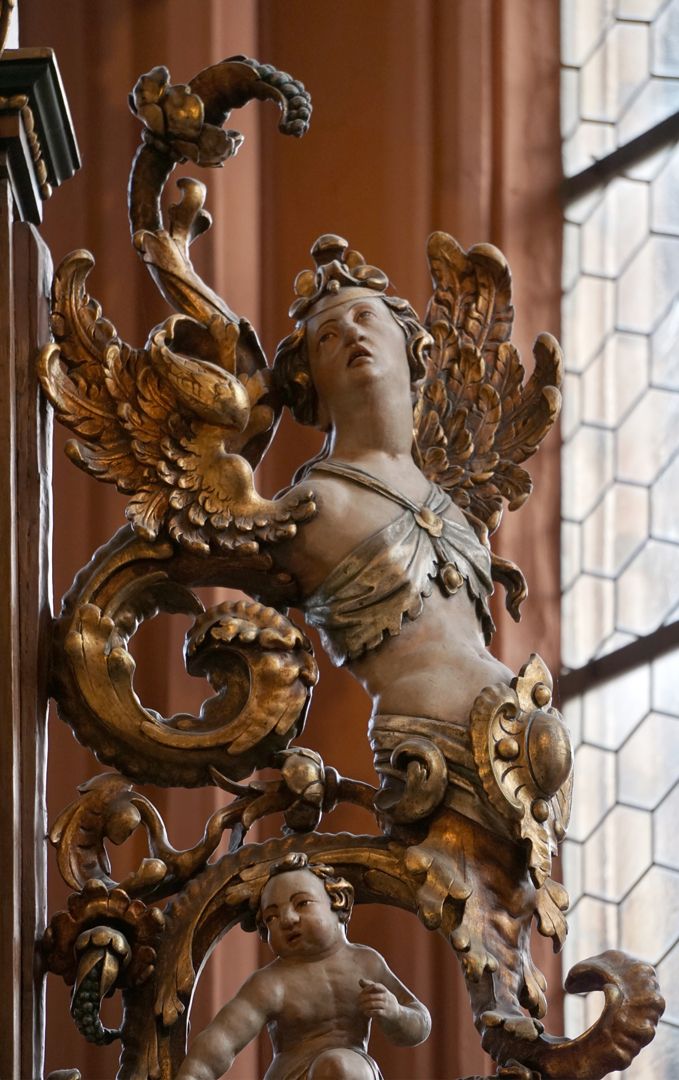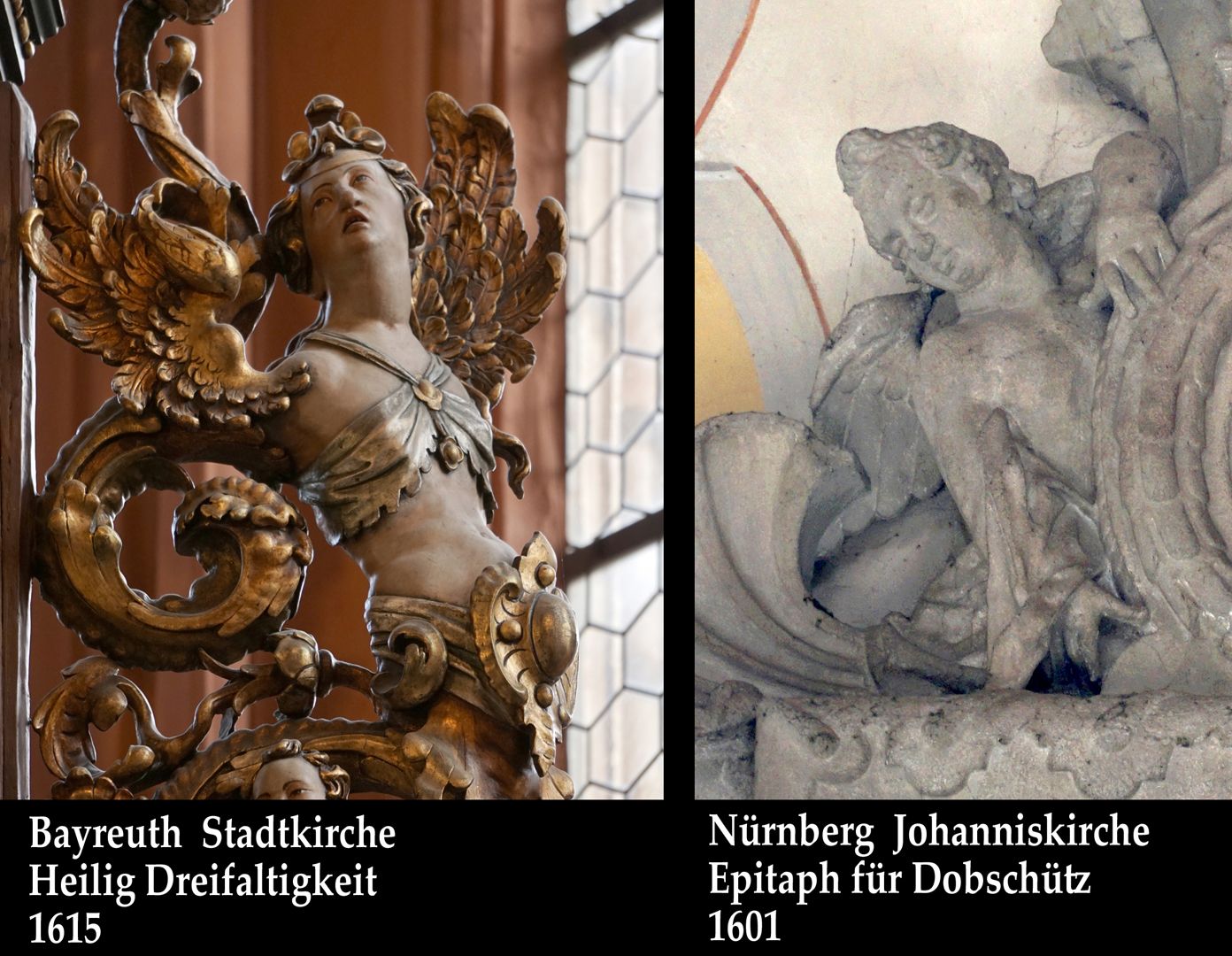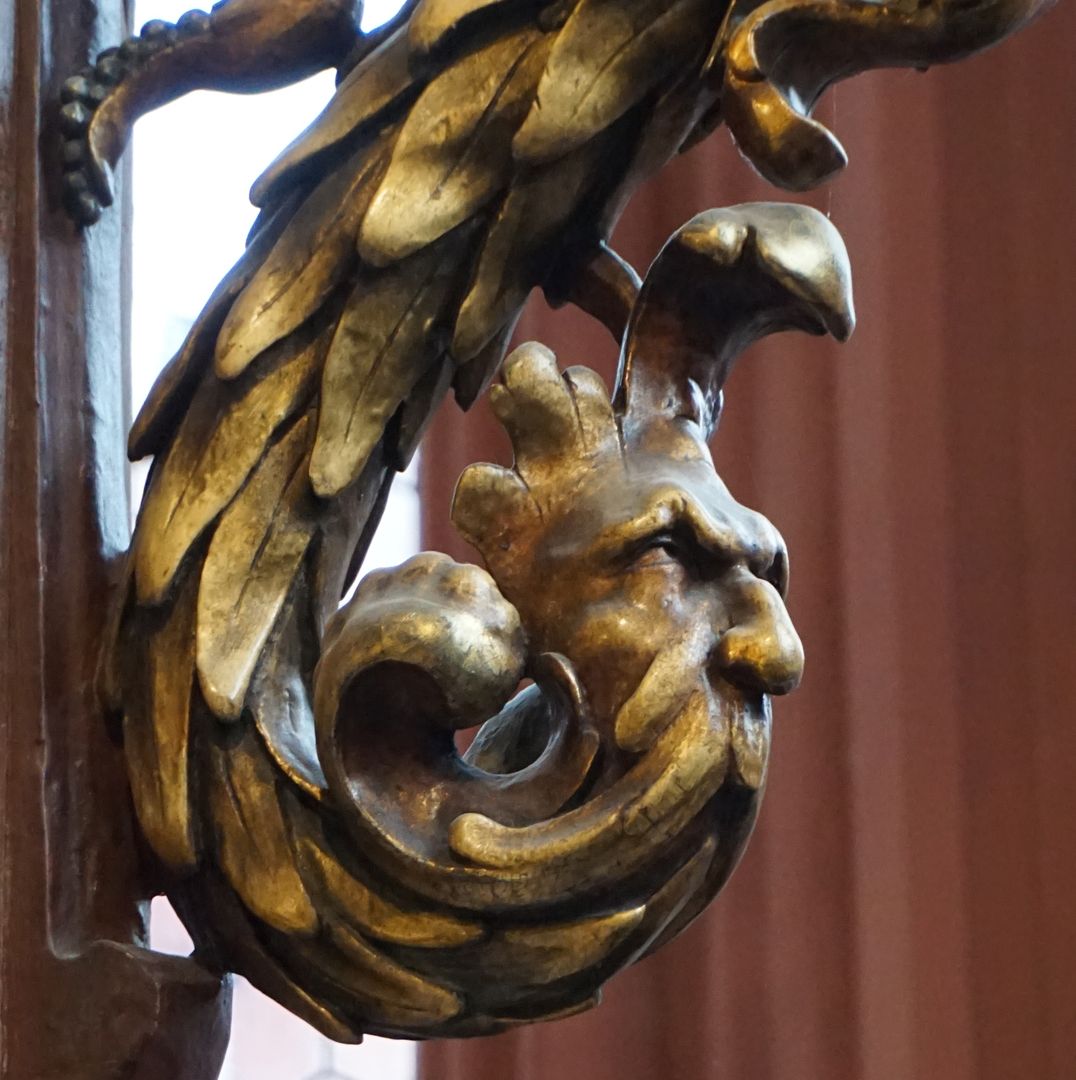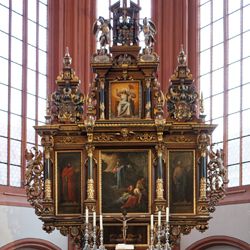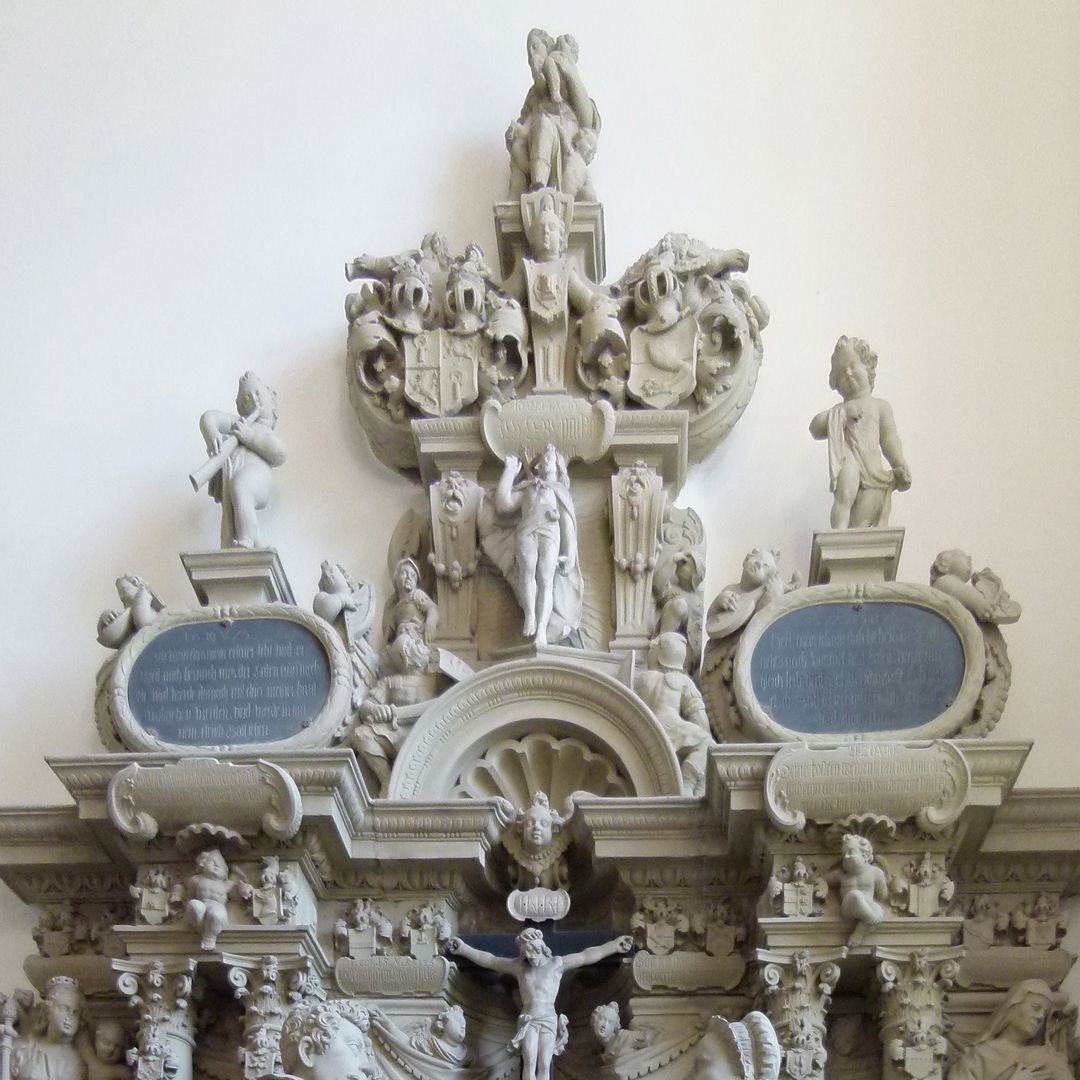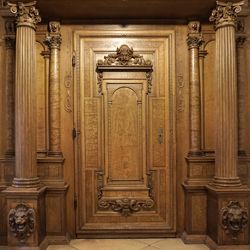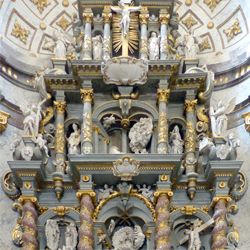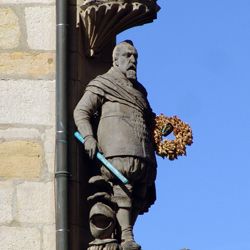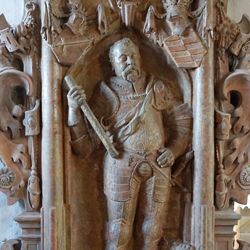High Altar
High Altar
1615
Baptismal font (marble reliefs by Hans Werner) and high altar in the choir room
dated 1615, donated by Margravine Maria of Brandenburg-Bayreuth.
Three-axis wooden construction with rich carved decoration of cartilage and metal fittings; the sides are finished with the founder's coat of arms between ornamental obelisks, the pelican and coat of arms with Passion insignia on the extension, flanked by angels and crowned by the Crucified; charming side panels.
Around 1820, the altarpieces were replaced by paintings by August Riedel: In the main field Christ on the Mount of Olives, flanked by the apostles Peter and Paul, in the attachment enthroned Salvator, all 1821/22; in the predella copy of the Last Supper (after Leonardo da Vinci) 1827 by Immanuel Friedrich Schuhmacher.
(Dehio / Franconia / Edited by Tilmann Breuer, Friedrich Oswald, Friedrich Piel, Wilhelm Schwemmer, and others / 1999)
_________________________
"During the reconstruction of the town church after the great fire of 1605, Werner was allowed to create the pulpit and the baptismal font. The high altar donated by Margravine Maria, whose pictures were painted by the court painter Heinrich Bolland, and the carved frame by Leonhard Brechtel of Nuremberg, date from the same period. We receive no documentary information about the carver of the frame, and we are not authorised to equate him with Brechtel, since experience shows that painting and gilding were entrusted to "experts" in each case. Sitzmann has repeatedly suggested that this altar frame also came from Werner. Sitzmann tries to refute the objection that our master did not work in wood by referring to the missing lid of the baptismal font in the same church, of which the old description tells us that it showed four figures of the cardinal virtues, which, since the lid was intended to be lifted off, must have been made of wood. Thus the carving technique would have been familiar to Werner, (...) Furthermore, it should be kept in mind that Dümpel was certainly Werner's assistant in 1615, and that wood carvings by him are known. (...)
The agreement in the typology of the putti heads speaks in favour of Werner's authorship (...)".
Felix Ettinghausen: Hans Werner, a Franconian sculptor around the year 1600 / dissertation / Würzburg / 1921 / p. 95 - 99
Location: Bayreuth, Holy Trinity City Church
Realization: Werner, Hans, Dümpel, Veit, Brechtel, Leonhard d. Ä.
photo 2022, Theo Noll
High Altar
1615
General view, high altar
dated 1615, donated by Margravine Maria of Brandenburg-Bayreuth.
Three-axis wooden construction with rich carved decoration of cartilage and metal fittings; the sides are finished with the founder's coat of arms between ornamental obelisks, the pelican and coat of arms with Passion insignia on the extension, flanked by angels and crowned by the Crucified; charming side panels.
Around 1820, the altarpieces were replaced by paintings by August Riedel: In the main field Christ on the Mount of Olives, flanked by the apostles Peter and Paul, in the attachment enthroned Salvator, all 1821/22; in the predella copy of the Last Supper (after Leonardo da Vinci) 1827 by Immanuel Friedrich Schuhmacher.
(Dehio / Franconia / Edited by Tilmann Breuer, Friedrich Oswald, Friedrich Piel, Wilhelm Schwemmer, and others / 1999)
_________________________
"During the reconstruction of the town church after the great fire of 1605, Werner was allowed to create the pulpit and the baptismal font. The high altar donated by Margravine Maria, whose pictures were painted by the court painter Heinrich Bolland, and the carved frame by Leonhard Brechtel of Nuremberg, date from the same period. We receive no documentary information about the carver of the frame, and we are not authorised to equate him with Brechtel, since experience shows that painting and gilding were entrusted to "experts" in each case. Sitzmann has repeatedly suggested that this altar frame also came from Werner. Sitzmann tries to refute the objection that our master did not work in wood by referring to the missing lid of the baptismal font in the same church, of which the old description tells us that it showed four figures of the cardinal virtues, which, since the lid was intended to be lifted off, must have been made of wood. Thus the carving technique would have been familiar to Werner, (...) Furthermore, it should be kept in mind that Dümpel was certainly Werner's assistant in 1615, and that wood carvings by him are known. (...)
The agreement in the typology of the putti heads speaks in favour of Werner's authorship (...)".
Felix Ettinghausen: Hans Werner, a Franconian sculptor around the year 1600 / dissertation / Würzburg / 1921 / p. 95 - 99
Location: Bayreuth, Holy Trinity City Church
Realization: Werner, Hans, Dümpel, Veit, Brechtel, Leonhard d. Ä.
photo 2022, Theo Noll
High Altar
1615
upper finial: crucifix, coat of arms with Passion insignia, below a pelican
dated 1615, donated by Margravine Maria of Brandenburg-Bayreuth.
Three-axis wooden construction with rich carved decoration of cartilage and metal fittings; the sides are finished with the founder's coat of arms between ornamental obelisks, the pelican and coat of arms with Passion insignia on the extension, flanked by angels and crowned by the Crucified; charming side panels.
Around 1820, the altarpieces were replaced by paintings by August Riedel: In the main field Christ on the Mount of Olives, flanked by the apostles Peter and Paul, in the attachment enthroned Salvator, all 1821/22; in the predella copy of the Last Supper (after Leonardo da Vinci) 1827 by Immanuel Friedrich Schuhmacher.
(Dehio / Franconia / Edited by Tilmann Breuer, Friedrich Oswald, Friedrich Piel, Wilhelm Schwemmer, and others / 1999)
_________________________
"During the reconstruction of the town church after the great fire of 1605, Werner was allowed to create the pulpit and the baptismal font. The high altar donated by Margravine Maria, whose pictures were painted by the court painter Heinrich Bolland, and the carved frame by Leonhard Brechtel of Nuremberg, date from the same period. We receive no documentary information about the carver of the frame, and we are not authorised to equate him with Brechtel, since experience shows that painting and gilding were entrusted to "experts" in each case. Sitzmann has repeatedly suggested that this altar frame also came from Werner. Sitzmann tries to refute the objection that our master did not work in wood by referring to the missing lid of the baptismal font in the same church, of which the old description tells us that it showed four figures of the cardinal virtues, which, since the lid was intended to be lifted off, must have been made of wood. Thus the carving technique would have been familiar to Werner, (...) Furthermore, it should be kept in mind that Dümpel was certainly Werner's assistant in 1615, and that wood carvings by him are known. (...)
The agreement in the typology of the putti heads speaks in favour of Werner's authorship (...)".
Felix Ettinghausen: Hans Werner, a Franconian sculptor around the year 1600 / dissertation / Würzburg / 1921 / p. 95 - 99
Location: Bayreuth, Holy Trinity City Church
Realization: Werner, Hans, Dümpel, Veit, Brechtel, Leonhard d. Ä.
photo 2022, Theo Noll
High Altar
1615
upper finial: crucifix, coat of arms with Passion insignia, below a pelican
dated 1615, donated by Margravine Maria of Brandenburg-Bayreuth.
Three-axis wooden construction with rich carved decoration of cartilage and metal fittings; the sides are finished with the founder's coat of arms between ornamental obelisks, the pelican and coat of arms with Passion insignia on the extension, flanked by angels and crowned by the Crucified; charming side panels.
Around 1820, the altarpieces were replaced by paintings by August Riedel: In the main field Christ on the Mount of Olives, flanked by the apostles Peter and Paul, in the attachment enthroned Salvator, all 1821/22; in the predella copy of the Last Supper (after Leonardo da Vinci) 1827 by Immanuel Friedrich Schuhmacher.
(Dehio / Franconia / Edited by Tilmann Breuer, Friedrich Oswald, Friedrich Piel, Wilhelm Schwemmer, and others / 1999)
_________________________
"During the reconstruction of the town church after the great fire of 1605, Werner was allowed to create the pulpit and the baptismal font. The high altar donated by Margravine Maria, whose pictures were painted by the court painter Heinrich Bolland, and the carved frame by Leonhard Brechtel of Nuremberg, date from the same period. We receive no documentary information about the carver of the frame, and we are not authorised to equate him with Brechtel, since experience shows that painting and gilding were entrusted to "experts" in each case. Sitzmann has repeatedly suggested that this altar frame also came from Werner. Sitzmann tries to refute the objection that our master did not work in wood by referring to the missing lid of the baptismal font in the same church, of which the old description tells us that it showed four figures of the cardinal virtues, which, since the lid was intended to be lifted off, must have been made of wood. Thus the carving technique would have been familiar to Werner, (...) Furthermore, it should be kept in mind that Dümpel was certainly Werner's assistant in 1615, and that wood carvings by him are known. (...)
The agreement in the typology of the putti heads speaks in favour of Werner's authorship (...)".
Felix Ettinghausen: Hans Werner, a Franconian sculptor around the year 1600 / dissertation / Würzburg / 1921 / p. 95 - 99
Location: Bayreuth, Holy Trinity City Church
Realization: Werner, Hans, Dümpel, Veit, Brechtel, Leonhard d. Ä.
photo 2022, Theo Noll
High Altar
1615
upper finial, with donators´coats of arms on the sides
dated 1615, donated by Margravine Maria of Brandenburg-Bayreuth.
Three-axis wooden construction with rich carved decoration of cartilage and metal fittings; the sides are finished with the founder's coat of arms between ornamental obelisks, the pelican and coat of arms with Passion insignia on the extension, flanked by angels and crowned by the Crucified; charming side panels.
Around 1820, the altarpieces were replaced by paintings by August Riedel: In the main field Christ on the Mount of Olives, flanked by the apostles Peter and Paul, in the attachment enthroned Salvator, all 1821/22; in the predella copy of the Last Supper (after Leonardo da Vinci) 1827 by Immanuel Friedrich Schuhmacher.
(Dehio / Franconia / Edited by Tilmann Breuer, Friedrich Oswald, Friedrich Piel, Wilhelm Schwemmer, and others / 1999)
_________________________
"During the reconstruction of the town church after the great fire of 1605, Werner was allowed to create the pulpit and the baptismal font. The high altar donated by Margravine Maria, whose pictures were painted by the court painter Heinrich Bolland, and the carved frame by Leonhard Brechtel of Nuremberg, date from the same period. We receive no documentary information about the carver of the frame, and we are not authorised to equate him with Brechtel, since experience shows that painting and gilding were entrusted to "experts" in each case. Sitzmann has repeatedly suggested that this altar frame also came from Werner. Sitzmann tries to refute the objection that our master did not work in wood by referring to the missing lid of the baptismal font in the same church, of which the old description tells us that it showed four figures of the cardinal virtues, which, since the lid was intended to be lifted off, must have been made of wood. Thus the carving technique would have been familiar to Werner, (...) Furthermore, it should be kept in mind that Dümpel was certainly Werner's assistant in 1615, and that wood carvings by him are known. (...)
The agreement in the typology of the putti heads speaks in favour of Werner's authorship (...)".
Felix Ettinghausen: Hans Werner, a Franconian sculptor around the year 1600 / dissertation / Würzburg / 1921 / p. 95 - 99
Location: Bayreuth, Holy Trinity City Church
Realization: Werner, Hans, Dümpel, Veit, Brechtel, Leonhard d. Ä.
photo 2022, Theo Noll
High Altar
1615
donators´coat of arms, left hand side
dated 1615, donated by Margravine Maria of Brandenburg-Bayreuth.
Three-axis wooden construction with rich carved decoration of cartilage and metal fittings; the sides are finished with the founder's coat of arms between ornamental obelisks, the pelican and coat of arms with Passion insignia on the extension, flanked by angels and crowned by the Crucified; charming side panels.
Around 1820, the altarpieces were replaced by paintings by August Riedel: In the main field Christ on the Mount of Olives, flanked by the apostles Peter and Paul, in the attachment enthroned Salvator, all 1821/22; in the predella copy of the Last Supper (after Leonardo da Vinci) 1827 by Immanuel Friedrich Schuhmacher.
(Dehio / Franconia / Edited by Tilmann Breuer, Friedrich Oswald, Friedrich Piel, Wilhelm Schwemmer, and others / 1999)
_________________________
"During the reconstruction of the town church after the great fire of 1605, Werner was allowed to create the pulpit and the baptismal font. The high altar donated by Margravine Maria, whose pictures were painted by the court painter Heinrich Bolland, and the carved frame by Leonhard Brechtel of Nuremberg, date from the same period. We receive no documentary information about the carver of the frame, and we are not authorised to equate him with Brechtel, since experience shows that painting and gilding were entrusted to "experts" in each case. Sitzmann has repeatedly suggested that this altar frame also came from Werner. Sitzmann tries to refute the objection that our master did not work in wood by referring to the missing lid of the baptismal font in the same church, of which the old description tells us that it showed four figures of the cardinal virtues, which, since the lid was intended to be lifted off, must have been made of wood. Thus the carving technique would have been familiar to Werner, (...) Furthermore, it should be kept in mind that Dümpel was certainly Werner's assistant in 1615, and that wood carvings by him are known. (...)
The agreement in the typology of the putti heads speaks in favour of Werner's authorship (...)".
Felix Ettinghausen: Hans Werner, a Franconian sculptor around the year 1600 / dissertation / Würzburg / 1921 / p. 95 - 99
Location: Bayreuth, Holy Trinity City Church
Realization: Werner, Hans, Dümpel, Veit, Brechtel, Leonhard d. Ä.
photo 2022, Theo Noll
High Altar
1615
Enthroned Salvator, painting by August Riedel 1821/22
dated 1615, donated by Margravine Maria of Brandenburg-Bayreuth.
Three-axis wooden construction with rich carved decoration of cartilage and metal fittings; the sides are finished with the founder's coat of arms between ornamental obelisks, the pelican and coat of arms with Passion insignia on the extension, flanked by angels and crowned by the Crucified; charming side panels.
Around 1820, the altarpieces were replaced by paintings by August Riedel: In the main field Christ on the Mount of Olives, flanked by the apostles Peter and Paul, in the attachment enthroned Salvator, all 1821/22; in the predella copy of the Last Supper (after Leonardo da Vinci) 1827 by Immanuel Friedrich Schuhmacher.
(Dehio / Franconia / Edited by Tilmann Breuer, Friedrich Oswald, Friedrich Piel, Wilhelm Schwemmer, and others / 1999)
_________________________
"During the reconstruction of the town church after the great fire of 1605, Werner was allowed to create the pulpit and the baptismal font. The high altar donated by Margravine Maria, whose pictures were painted by the court painter Heinrich Bolland, and the carved frame by Leonhard Brechtel of Nuremberg, date from the same period. We receive no documentary information about the carver of the frame, and we are not authorised to equate him with Brechtel, since experience shows that painting and gilding were entrusted to "experts" in each case. Sitzmann has repeatedly suggested that this altar frame also came from Werner. Sitzmann tries to refute the objection that our master did not work in wood by referring to the missing lid of the baptismal font in the same church, of which the old description tells us that it showed four figures of the cardinal virtues, which, since the lid was intended to be lifted off, must have been made of wood. Thus the carving technique would have been familiar to Werner, (...) Furthermore, it should be kept in mind that Dümpel was certainly Werner's assistant in 1615, and that wood carvings by him are known. (...)
The agreement in the typology of the putti heads speaks in favour of Werner's authorship (...)".
Felix Ettinghausen: Hans Werner, a Franconian sculptor around the year 1600 / dissertation / Würzburg / 1921 / p. 95 - 99
Location: Bayreuth, Holy Trinity City Church
Realization: Werner, Hans, Dümpel, Veit, Brechtel, Leonhard d. Ä.
photo 2022, Theo Noll
High Altar
1615
donators´coat of arms, right hand side
dated 1615, donated by Margravine Maria of Brandenburg-Bayreuth.
Three-axis wooden construction with rich carved decoration of cartilage and metal fittings; the sides are finished with the founder's coat of arms between ornamental obelisks, the pelican and coat of arms with Passion insignia on the extension, flanked by angels and crowned by the Crucified; charming side panels.
Around 1820, the altarpieces were replaced by paintings by August Riedel: In the main field Christ on the Mount of Olives, flanked by the apostles Peter and Paul, in the attachment enthroned Salvator, all 1821/22; in the predella copy of the Last Supper (after Leonardo da Vinci) 1827 by Immanuel Friedrich Schuhmacher.
(Dehio / Franconia / Edited by Tilmann Breuer, Friedrich Oswald, Friedrich Piel, Wilhelm Schwemmer, and others / 1999)
_________________________
"During the reconstruction of the town church after the great fire of 1605, Werner was allowed to create the pulpit and the baptismal font. The high altar donated by Margravine Maria, whose pictures were painted by the court painter Heinrich Bolland, and the carved frame by Leonhard Brechtel of Nuremberg, date from the same period. We receive no documentary information about the carver of the frame, and we are not authorised to equate him with Brechtel, since experience shows that painting and gilding were entrusted to "experts" in each case. Sitzmann has repeatedly suggested that this altar frame also came from Werner. Sitzmann tries to refute the objection that our master did not work in wood by referring to the missing lid of the baptismal font in the same church, of which the old description tells us that it showed four figures of the cardinal virtues, which, since the lid was intended to be lifted off, must have been made of wood. Thus the carving technique would have been familiar to Werner, (...) Furthermore, it should be kept in mind that Dümpel was certainly Werner's assistant in 1615, and that wood carvings by him are known. (...)
The agreement in the typology of the putti heads speaks in favour of Werner's authorship (...)".
Felix Ettinghausen: Hans Werner, a Franconian sculptor around the year 1600 / dissertation / Würzburg / 1921 / p. 95 - 99
Location: Bayreuth, Holy Trinity City Church
Realization: Werner, Hans, Dümpel, Veit, Brechtel, Leonhard d. Ä.
photo 2022, Theo Noll
High Altar
1615
Altar panels, paintings by August Riedel, 1821/22
dated 1615, donated by Margravine Maria of Brandenburg-Bayreuth.
Three-axis wooden construction with rich carved decoration of cartilage and metal fittings; the sides are finished with the founder's coat of arms between ornamental obelisks, the pelican and coat of arms with Passion insignia on the extension, flanked by angels and crowned by the Crucified; charming side panels.
Around 1820, the altarpieces were replaced by paintings by August Riedel: In the main field Christ on the Mount of Olives, flanked by the apostles Peter and Paul, in the attachment enthroned Salvator, all 1821/22; in the predella copy of the Last Supper (after Leonardo da Vinci) 1827 by Immanuel Friedrich Schuhmacher.
(Dehio / Franconia / Edited by Tilmann Breuer, Friedrich Oswald, Friedrich Piel, Wilhelm Schwemmer, and others / 1999)
_________________________
"During the reconstruction of the town church after the great fire of 1605, Werner was allowed to create the pulpit and the baptismal font. The high altar donated by Margravine Maria, whose pictures were painted by the court painter Heinrich Bolland, and the carved frame by Leonhard Brechtel of Nuremberg, date from the same period. We receive no documentary information about the carver of the frame, and we are not authorised to equate him with Brechtel, since experience shows that painting and gilding were entrusted to "experts" in each case. Sitzmann has repeatedly suggested that this altar frame also came from Werner. Sitzmann tries to refute the objection that our master did not work in wood by referring to the missing lid of the baptismal font in the same church, of which the old description tells us that it showed four figures of the cardinal virtues, which, since the lid was intended to be lifted off, must have been made of wood. Thus the carving technique would have been familiar to Werner, (...) Furthermore, it should be kept in mind that Dümpel was certainly Werner's assistant in 1615, and that wood carvings by him are known. (...)
The agreement in the typology of the putti heads speaks in favour of Werner's authorship (...)".
Felix Ettinghausen: Hans Werner, a Franconian sculptor around the year 1600 / dissertation / Würzburg / 1921 / p. 95 - 99
Location: Bayreuth, Holy Trinity City Church
Realization: Werner, Hans, Dümpel, Veit, Brechtel, Leonhard d. Ä.
photo 2022, Theo Noll
High Altar
1615
lateral auricular style carving by Werner / painting of St. Peter by August Riedel, 1821/22
dated 1615, donated by Margravine Maria of Brandenburg-Bayreuth.
Three-axis wooden construction with rich carved decoration of cartilage and metal fittings; the sides are finished with the founder's coat of arms between ornamental obelisks, the pelican and coat of arms with Passion insignia on the extension, flanked by angels and crowned by the Crucified; charming side panels.
Around 1820, the altarpieces were replaced by paintings by August Riedel: In the main field Christ on the Mount of Olives, flanked by the apostles Peter and Paul, in the attachment enthroned Salvator, all 1821/22; in the predella copy of the Last Supper (after Leonardo da Vinci) 1827 by Immanuel Friedrich Schuhmacher.
(Dehio / Franconia / Edited by Tilmann Breuer, Friedrich Oswald, Friedrich Piel, Wilhelm Schwemmer, and others / 1999)
_________________________
"During the reconstruction of the town church after the great fire of 1605, Werner was allowed to create the pulpit and the baptismal font. The high altar donated by Margravine Maria, whose pictures were painted by the court painter Heinrich Bolland, and the carved frame by Leonhard Brechtel of Nuremberg, date from the same period. We receive no documentary information about the carver of the frame, and we are not authorised to equate him with Brechtel, since experience shows that painting and gilding were entrusted to "experts" in each case. Sitzmann has repeatedly suggested that this altar frame also came from Werner. Sitzmann tries to refute the objection that our master did not work in wood by referring to the missing lid of the baptismal font in the same church, of which the old description tells us that it showed four figures of the cardinal virtues, which, since the lid was intended to be lifted off, must have been made of wood. Thus the carving technique would have been familiar to Werner, (...) Furthermore, it should be kept in mind that Dümpel was certainly Werner's assistant in 1615, and that wood carvings by him are known. (...)
The agreement in the typology of the putti heads speaks in favour of Werner's authorship (...)".
Felix Ettinghausen: Hans Werner, a Franconian sculptor around the year 1600 / dissertation / Würzburg / 1921 / p. 95 - 99
Location: Bayreuth, Holy Trinity City Church
Realization: Werner, Hans, Dümpel, Veit, Brechtel, Leonhard d. Ä.
photo 2022, Theo Noll
High Altar
1615
lateral auricular style carving, detail
dated 1615, donated by Margravine Maria of Brandenburg-Bayreuth.
Three-axis wooden construction with rich carved decoration of cartilage and metal fittings; the sides are finished with the founder's coat of arms between ornamental obelisks, the pelican and coat of arms with Passion insignia on the extension, flanked by angels and crowned by the Crucified; charming side panels.
Around 1820, the altarpieces were replaced by paintings by August Riedel: In the main field Christ on the Mount of Olives, flanked by the apostles Peter and Paul, in the attachment enthroned Salvator, all 1821/22; in the predella copy of the Last Supper (after Leonardo da Vinci) 1827 by Immanuel Friedrich Schuhmacher.
(Dehio / Franconia / Edited by Tilmann Breuer, Friedrich Oswald, Friedrich Piel, Wilhelm Schwemmer, and others / 1999)
_________________________
"During the reconstruction of the town church after the great fire of 1605, Werner was allowed to create the pulpit and the baptismal font. The high altar donated by Margravine Maria, whose pictures were painted by the court painter Heinrich Bolland, and the carved frame by Leonhard Brechtel of Nuremberg, date from the same period. We receive no documentary information about the carver of the frame, and we are not authorised to equate him with Brechtel, since experience shows that painting and gilding were entrusted to "experts" in each case. Sitzmann has repeatedly suggested that this altar frame also came from Werner. Sitzmann tries to refute the objection that our master did not work in wood by referring to the missing lid of the baptismal font in the same church, of which the old description tells us that it showed four figures of the cardinal virtues, which, since the lid was intended to be lifted off, must have been made of wood. Thus the carving technique would have been familiar to Werner, (...) Furthermore, it should be kept in mind that Dümpel was certainly Werner's assistant in 1615, and that wood carvings by him are known. (...)
The agreement in the typology of the putti heads speaks in favour of Werner's authorship (...)".
Felix Ettinghausen: Hans Werner, a Franconian sculptor around the year 1600 / dissertation / Würzburg / 1921 / p. 95 - 99
Location: Bayreuth, Holy Trinity City Church
Realization: Werner, Hans, Dümpel, Veit, Brechtel, Leonhard d. Ä.
photo 2022, Theo Noll
High Altar
1615
Mitteltafel mit Ölbergszene, Gemälde von August Riedel, 1821/22
dated 1615, donated by Margravine Maria of Brandenburg-Bayreuth.
Three-axis wooden construction with rich carved decoration of cartilage and metal fittings; the sides are finished with the founder's coat of arms between ornamental obelisks, the pelican and coat of arms with Passion insignia on the extension, flanked by angels and crowned by the Crucified; charming side panels.
Around 1820, the altarpieces were replaced by paintings by August Riedel: In the main field Christ on the Mount of Olives, flanked by the apostles Peter and Paul, in the attachment enthroned Salvator, all 1821/22; in the predella copy of the Last Supper (after Leonardo da Vinci) 1827 by Immanuel Friedrich Schuhmacher.
(Dehio / Franconia / Edited by Tilmann Breuer, Friedrich Oswald, Friedrich Piel, Wilhelm Schwemmer, and others / 1999)
_________________________
"During the reconstruction of the town church after the great fire of 1605, Werner was allowed to create the pulpit and the baptismal font. The high altar donated by Margravine Maria, whose pictures were painted by the court painter Heinrich Bolland, and the carved frame by Leonhard Brechtel of Nuremberg, date from the same period. We receive no documentary information about the carver of the frame, and we are not authorised to equate him with Brechtel, since experience shows that painting and gilding were entrusted to "experts" in each case. Sitzmann has repeatedly suggested that this altar frame also came from Werner. Sitzmann tries to refute the objection that our master did not work in wood by referring to the missing lid of the baptismal font in the same church, of which the old description tells us that it showed four figures of the cardinal virtues, which, since the lid was intended to be lifted off, must have been made of wood. Thus the carving technique would have been familiar to Werner, (...) Furthermore, it should be kept in mind that Dümpel was certainly Werner's assistant in 1615, and that wood carvings by him are known. (...)
The agreement in the typology of the putti heads speaks in favour of Werner's authorship (...)".
Felix Ettinghausen: Hans Werner, a Franconian sculptor around the year 1600 / dissertation / Würzburg / 1921 / p. 95 - 99
Location: Bayreuth, Holy Trinity City Church
Realization: Werner, Hans, Dümpel, Veit, Brechtel, Leonhard d. Ä.
photo 2022, Theo Noll
High Altar
1615
lateral auricular style carving by Werner / painting of St. Peter by August Riedel, 1821/22
dated 1615, donated by Margravine Maria of Brandenburg-Bayreuth.
Three-axis wooden construction with rich carved decoration of cartilage and metal fittings; the sides are finished with the founder's coat of arms between ornamental obelisks, the pelican and coat of arms with Passion insignia on the extension, flanked by angels and crowned by the Crucified; charming side panels.
Around 1820, the altarpieces were replaced by paintings by August Riedel: In the main field Christ on the Mount of Olives, flanked by the apostles Peter and Paul, in the attachment enthroned Salvator, all 1821/22; in the predella copy of the Last Supper (after Leonardo da Vinci) 1827 by Immanuel Friedrich Schuhmacher.
(Dehio / Franconia / Edited by Tilmann Breuer, Friedrich Oswald, Friedrich Piel, Wilhelm Schwemmer, and others / 1999)
_________________________
"During the reconstruction of the town church after the great fire of 1605, Werner was allowed to create the pulpit and the baptismal font. The high altar donated by Margravine Maria, whose pictures were painted by the court painter Heinrich Bolland, and the carved frame by Leonhard Brechtel of Nuremberg, date from the same period. We receive no documentary information about the carver of the frame, and we are not authorised to equate him with Brechtel, since experience shows that painting and gilding were entrusted to "experts" in each case. Sitzmann has repeatedly suggested that this altar frame also came from Werner. Sitzmann tries to refute the objection that our master did not work in wood by referring to the missing lid of the baptismal font in the same church, of which the old description tells us that it showed four figures of the cardinal virtues, which, since the lid was intended to be lifted off, must have been made of wood. Thus the carving technique would have been familiar to Werner, (...) Furthermore, it should be kept in mind that Dümpel was certainly Werner's assistant in 1615, and that wood carvings by him are known. (...)
The agreement in the typology of the putti heads speaks in favour of Werner's authorship (...)".
Felix Ettinghausen: Hans Werner, a Franconian sculptor around the year 1600 / dissertation / Würzburg / 1921 / p. 95 - 99
Location: Bayreuth, Holy Trinity City Church
Realization: Werner, Hans, Dümpel, Veit, Brechtel, Leonhard d. Ä.
photo 2022, Theo Noll
High Altar
1615
left lateral auricular style carving
dated 1615, donated by Margravine Maria of Brandenburg-Bayreuth.
Three-axis wooden construction with rich carved decoration of cartilage and metal fittings; the sides are finished with the founder's coat of arms between ornamental obelisks, the pelican and coat of arms with Passion insignia on the extension, flanked by angels and crowned by the Crucified; charming side panels.
Around 1820, the altarpieces were replaced by paintings by August Riedel: In the main field Christ on the Mount of Olives, flanked by the apostles Peter and Paul, in the attachment enthroned Salvator, all 1821/22; in the predella copy of the Last Supper (after Leonardo da Vinci) 1827 by Immanuel Friedrich Schuhmacher.
(Dehio / Franconia / Edited by Tilmann Breuer, Friedrich Oswald, Friedrich Piel, Wilhelm Schwemmer, and others / 1999)
_________________________
"During the reconstruction of the town church after the great fire of 1605, Werner was allowed to create the pulpit and the baptismal font. The high altar donated by Margravine Maria, whose pictures were painted by the court painter Heinrich Bolland, and the carved frame by Leonhard Brechtel of Nuremberg, date from the same period. We receive no documentary information about the carver of the frame, and we are not authorised to equate him with Brechtel, since experience shows that painting and gilding were entrusted to "experts" in each case. Sitzmann has repeatedly suggested that this altar frame also came from Werner. Sitzmann tries to refute the objection that our master did not work in wood by referring to the missing lid of the baptismal font in the same church, of which the old description tells us that it showed four figures of the cardinal virtues, which, since the lid was intended to be lifted off, must have been made of wood. Thus the carving technique would have been familiar to Werner, (...) Furthermore, it should be kept in mind that Dümpel was certainly Werner's assistant in 1615, and that wood carvings by him are known. (...)
The agreement in the typology of the putti heads speaks in favour of Werner's authorship (...)".
Felix Ettinghausen: Hans Werner, a Franconian sculptor around the year 1600 / dissertation / Würzburg / 1921 / p. 95 - 99
Location: Bayreuth, Holy Trinity City Church
Realization: Werner, Hans, Dümpel, Veit, Brechtel, Leonhard d. Ä.
photo 2022, Theo Noll
High Altar
1615
left lateral auricular style carving, detail view
dated 1615, donated by Margravine Maria of Brandenburg-Bayreuth.
Three-axis wooden construction with rich carved decoration of cartilage and metal fittings; the sides are finished with the founder's coat of arms between ornamental obelisks, the pelican and coat of arms with Passion insignia on the extension, flanked by angels and crowned by the Crucified; charming side panels.
Around 1820, the altarpieces were replaced by paintings by August Riedel: In the main field Christ on the Mount of Olives, flanked by the apostles Peter and Paul, in the attachment enthroned Salvator, all 1821/22; in the predella copy of the Last Supper (after Leonardo da Vinci) 1827 by Immanuel Friedrich Schuhmacher.
(Dehio / Franconia / Edited by Tilmann Breuer, Friedrich Oswald, Friedrich Piel, Wilhelm Schwemmer, and others / 1999)
_________________________
"During the reconstruction of the town church after the great fire of 1605, Werner was allowed to create the pulpit and the baptismal font. The high altar donated by Margravine Maria, whose pictures were painted by the court painter Heinrich Bolland, and the carved frame by Leonhard Brechtel of Nuremberg, date from the same period. We receive no documentary information about the carver of the frame, and we are not authorised to equate him with Brechtel, since experience shows that painting and gilding were entrusted to "experts" in each case. Sitzmann has repeatedly suggested that this altar frame also came from Werner. Sitzmann tries to refute the objection that our master did not work in wood by referring to the missing lid of the baptismal font in the same church, of which the old description tells us that it showed four figures of the cardinal virtues, which, since the lid was intended to be lifted off, must have been made of wood. Thus the carving technique would have been familiar to Werner, (...) Furthermore, it should be kept in mind that Dümpel was certainly Werner's assistant in 1615, and that wood carvings by him are known. (...)
The agreement in the typology of the putti heads speaks in favour of Werner's authorship (...)".
Felix Ettinghausen: Hans Werner, a Franconian sculptor around the year 1600 / dissertation / Würzburg / 1921 / p. 95 - 99
Location: Bayreuth, Holy Trinity City Church
Realization: Werner, Hans, Dümpel, Veit, Brechtel, Leonhard d. Ä.
photo 2022, Theo Noll
High Altar
1615
left lateral auricular style carving, detail view with putto
dated 1615, donated by Margravine Maria of Brandenburg-Bayreuth.
Three-axis wooden construction with rich carved decoration of cartilage and metal fittings; the sides are finished with the founder's coat of arms between ornamental obelisks, the pelican and coat of arms with Passion insignia on the extension, flanked by angels and crowned by the Crucified; charming side panels.
Around 1820, the altarpieces were replaced by paintings by August Riedel: In the main field Christ on the Mount of Olives, flanked by the apostles Peter and Paul, in the attachment enthroned Salvator, all 1821/22; in the predella copy of the Last Supper (after Leonardo da Vinci) 1827 by Immanuel Friedrich Schuhmacher.
(Dehio / Franconia / Edited by Tilmann Breuer, Friedrich Oswald, Friedrich Piel, Wilhelm Schwemmer, and others / 1999)
_________________________
"During the reconstruction of the town church after the great fire of 1605, Werner was allowed to create the pulpit and the baptismal font. The high altar donated by Margravine Maria, whose pictures were painted by the court painter Heinrich Bolland, and the carved frame by Leonhard Brechtel of Nuremberg, date from the same period. We receive no documentary information about the carver of the frame, and we are not authorised to equate him with Brechtel, since experience shows that painting and gilding were entrusted to "experts" in each case. Sitzmann has repeatedly suggested that this altar frame also came from Werner. Sitzmann tries to refute the objection that our master did not work in wood by referring to the missing lid of the baptismal font in the same church, of which the old description tells us that it showed four figures of the cardinal virtues, which, since the lid was intended to be lifted off, must have been made of wood. Thus the carving technique would have been familiar to Werner, (...) Furthermore, it should be kept in mind that Dümpel was certainly Werner's assistant in 1615, and that wood carvings by him are known. (...)
The agreement in the typology of the putti heads speaks in favour of Werner's authorship (...)".
Felix Ettinghausen: Hans Werner, a Franconian sculptor around the year 1600 / dissertation / Würzburg / 1921 / p. 95 - 99
Location: Bayreuth, Holy Trinity City Church
Realization: Werner, Hans, Dümpel, Veit, Brechtel, Leonhard d. Ä.
photo 2022, Theo Noll
High Altar
1615
left lateral auricular style carving, detail view of the lower end
dated 1615, donated by Margravine Maria of Brandenburg-Bayreuth.
Three-axis wooden construction with rich carved decoration of cartilage and metal fittings; the sides are finished with the founder's coat of arms between ornamental obelisks, the pelican and coat of arms with Passion insignia on the extension, flanked by angels and crowned by the Crucified; charming side panels.
Around 1820, the altarpieces were replaced by paintings by August Riedel: In the main field Christ on the Mount of Olives, flanked by the apostles Peter and Paul, in the attachment enthroned Salvator, all 1821/22; in the predella copy of the Last Supper (after Leonardo da Vinci) 1827 by Immanuel Friedrich Schuhmacher.
(Dehio / Franconia / Edited by Tilmann Breuer, Friedrich Oswald, Friedrich Piel, Wilhelm Schwemmer, and others / 1999)
_________________________
"During the reconstruction of the town church after the great fire of 1605, Werner was allowed to create the pulpit and the baptismal font. The high altar donated by Margravine Maria, whose pictures were painted by the court painter Heinrich Bolland, and the carved frame by Leonhard Brechtel of Nuremberg, date from the same period. We receive no documentary information about the carver of the frame, and we are not authorised to equate him with Brechtel, since experience shows that painting and gilding were entrusted to "experts" in each case. Sitzmann has repeatedly suggested that this altar frame also came from Werner. Sitzmann tries to refute the objection that our master did not work in wood by referring to the missing lid of the baptismal font in the same church, of which the old description tells us that it showed four figures of the cardinal virtues, which, since the lid was intended to be lifted off, must have been made of wood. Thus the carving technique would have been familiar to Werner, (...) Furthermore, it should be kept in mind that Dümpel was certainly Werner's assistant in 1615, and that wood carvings by him are known. (...)
The agreement in the typology of the putti heads speaks in favour of Werner's authorship (...)".
Felix Ettinghausen: Hans Werner, a Franconian sculptor around the year 1600 / dissertation / Würzburg / 1921 / p. 95 - 99
Location: Bayreuth, Holy Trinity City Church
Realization: Werner, Hans, Dümpel, Veit, Brechtel, Leonhard d. Ä.
photo 2022, Theo Noll
High Altar
1615
Hanging head capital on the right hand side with biblical quotation from Corinthians I: " As often as ye eat of this bread...."
dated 1615, donated by Margravine Maria of Brandenburg-Bayreuth.
Three-axis wooden construction with rich carved decoration of cartilage and metal fittings; the sides are finished with the founder's coat of arms between ornamental obelisks, the pelican and coat of arms with Passion insignia on the extension, flanked by angels and crowned by the Crucified; charming side panels.
Around 1820, the altarpieces were replaced by paintings by August Riedel: In the main field Christ on the Mount of Olives, flanked by the apostles Peter and Paul, in the attachment enthroned Salvator, all 1821/22; in the predella copy of the Last Supper (after Leonardo da Vinci) 1827 by Immanuel Friedrich Schuhmacher.
(Dehio / Franconia / Edited by Tilmann Breuer, Friedrich Oswald, Friedrich Piel, Wilhelm Schwemmer, and others / 1999)
_________________________
"During the reconstruction of the town church after the great fire of 1605, Werner was allowed to create the pulpit and the baptismal font. The high altar donated by Margravine Maria, whose pictures were painted by the court painter Heinrich Bolland, and the carved frame by Leonhard Brechtel of Nuremberg, date from the same period. We receive no documentary information about the carver of the frame, and we are not authorised to equate him with Brechtel, since experience shows that painting and gilding were entrusted to "experts" in each case. Sitzmann has repeatedly suggested that this altar frame also came from Werner. Sitzmann tries to refute the objection that our master did not work in wood by referring to the missing lid of the baptismal font in the same church, of which the old description tells us that it showed four figures of the cardinal virtues, which, since the lid was intended to be lifted off, must have been made of wood. Thus the carving technique would have been familiar to Werner, (...) Furthermore, it should be kept in mind that Dümpel was certainly Werner's assistant in 1615, and that wood carvings by him are known. (...)
The agreement in the typology of the putti heads speaks in favour of Werner's authorship (...)".
Felix Ettinghausen: Hans Werner, a Franconian sculptor around the year 1600 / dissertation / Würzburg / 1921 / p. 95 - 99
Location: Bayreuth, Holy Trinity City Church
Realization: Werner, Hans, Dümpel, Veit, Brechtel, Leonhard d. Ä.
photo 2022, Theo Noll
High Altar
1615
Cartouche with biblical quotation from Corinthians I: " As often as ye eat of this bread...."
dated 1615, donated by Margravine Maria of Brandenburg-Bayreuth.
Three-axis wooden construction with rich carved decoration of cartilage and metal fittings; the sides are finished with the founder's coat of arms between ornamental obelisks, the pelican and coat of arms with Passion insignia on the extension, flanked by angels and crowned by the Crucified; charming side panels.
Around 1820, the altarpieces were replaced by paintings by August Riedel: In the main field Christ on the Mount of Olives, flanked by the apostles Peter and Paul, in the attachment enthroned Salvator, all 1821/22; in the predella copy of the Last Supper (after Leonardo da Vinci) 1827 by Immanuel Friedrich Schuhmacher.
(Dehio / Franconia / Edited by Tilmann Breuer, Friedrich Oswald, Friedrich Piel, Wilhelm Schwemmer, and others / 1999)
_________________________
"During the reconstruction of the town church after the great fire of 1605, Werner was allowed to create the pulpit and the baptismal font. The high altar donated by Margravine Maria, whose pictures were painted by the court painter Heinrich Bolland, and the carved frame by Leonhard Brechtel of Nuremberg, date from the same period. We receive no documentary information about the carver of the frame, and we are not authorised to equate him with Brechtel, since experience shows that painting and gilding were entrusted to "experts" in each case. Sitzmann has repeatedly suggested that this altar frame also came from Werner. Sitzmann tries to refute the objection that our master did not work in wood by referring to the missing lid of the baptismal font in the same church, of which the old description tells us that it showed four figures of the cardinal virtues, which, since the lid was intended to be lifted off, must have been made of wood. Thus the carving technique would have been familiar to Werner, (...) Furthermore, it should be kept in mind that Dümpel was certainly Werner's assistant in 1615, and that wood carvings by him are known. (...)
The agreement in the typology of the putti heads speaks in favour of Werner's authorship (...)".
Felix Ettinghausen: Hans Werner, a Franconian sculptor around the year 1600 / dissertation / Würzburg / 1921 / p. 95 - 99
Location: Bayreuth, Holy Trinity City Church
Realization: Werner, Hans, Dümpel, Veit, Brechtel, Leonhard d. Ä.
photo 2022, Theo Noll
High Altar
1615
Hanging head capital
dated 1615, donated by Margravine Maria of Brandenburg-Bayreuth.
Three-axis wooden construction with rich carved decoration of cartilage and metal fittings; the sides are finished with the founder's coat of arms between ornamental obelisks, the pelican and coat of arms with Passion insignia on the extension, flanked by angels and crowned by the Crucified; charming side panels.
Around 1820, the altarpieces were replaced by paintings by August Riedel: In the main field Christ on the Mount of Olives, flanked by the apostles Peter and Paul, in the attachment enthroned Salvator, all 1821/22; in the predella copy of the Last Supper (after Leonardo da Vinci) 1827 by Immanuel Friedrich Schuhmacher.
(Dehio / Franconia / Edited by Tilmann Breuer, Friedrich Oswald, Friedrich Piel, Wilhelm Schwemmer, and others / 1999)
_________________________
"During the reconstruction of the town church after the great fire of 1605, Werner was allowed to create the pulpit and the baptismal font. The high altar donated by Margravine Maria, whose pictures were painted by the court painter Heinrich Bolland, and the carved frame by Leonhard Brechtel of Nuremberg, date from the same period. We receive no documentary information about the carver of the frame, and we are not authorised to equate him with Brechtel, since experience shows that painting and gilding were entrusted to "experts" in each case. Sitzmann has repeatedly suggested that this altar frame also came from Werner. Sitzmann tries to refute the objection that our master did not work in wood by referring to the missing lid of the baptismal font in the same church, of which the old description tells us that it showed four figures of the cardinal virtues, which, since the lid was intended to be lifted off, must have been made of wood. Thus the carving technique would have been familiar to Werner, (...) Furthermore, it should be kept in mind that Dümpel was certainly Werner's assistant in 1615, and that wood carvings by him are known. (...)
The agreement in the typology of the putti heads speaks in favour of Werner's authorship (...)".
Felix Ettinghausen: Hans Werner, a Franconian sculptor around the year 1600 / dissertation / Würzburg / 1921 / p. 95 - 99
Location: Bayreuth, Holy Trinity City Church
Realization: Werner, Hans, Dümpel, Veit, Brechtel, Leonhard d. Ä.
photo 2022, Theo Noll
High Altar
1615
Hanging head capital
dated 1615, donated by Margravine Maria of Brandenburg-Bayreuth.
Three-axis wooden construction with rich carved decoration of cartilage and metal fittings; the sides are finished with the founder's coat of arms between ornamental obelisks, the pelican and coat of arms with Passion insignia on the extension, flanked by angels and crowned by the Crucified; charming side panels.
Around 1820, the altarpieces were replaced by paintings by August Riedel: In the main field Christ on the Mount of Olives, flanked by the apostles Peter and Paul, in the attachment enthroned Salvator, all 1821/22; in the predella copy of the Last Supper (after Leonardo da Vinci) 1827 by Immanuel Friedrich Schuhmacher.
(Dehio / Franconia / Edited by Tilmann Breuer, Friedrich Oswald, Friedrich Piel, Wilhelm Schwemmer, and others / 1999)
_________________________
"During the reconstruction of the town church after the great fire of 1605, Werner was allowed to create the pulpit and the baptismal font. The high altar donated by Margravine Maria, whose pictures were painted by the court painter Heinrich Bolland, and the carved frame by Leonhard Brechtel of Nuremberg, date from the same period. We receive no documentary information about the carver of the frame, and we are not authorised to equate him with Brechtel, since experience shows that painting and gilding were entrusted to "experts" in each case. Sitzmann has repeatedly suggested that this altar frame also came from Werner. Sitzmann tries to refute the objection that our master did not work in wood by referring to the missing lid of the baptismal font in the same church, of which the old description tells us that it showed four figures of the cardinal virtues, which, since the lid was intended to be lifted off, must have been made of wood. Thus the carving technique would have been familiar to Werner, (...) Furthermore, it should be kept in mind that Dümpel was certainly Werner's assistant in 1615, and that wood carvings by him are known. (...)
The agreement in the typology of the putti heads speaks in favour of Werner's authorship (...)".
Felix Ettinghausen: Hans Werner, a Franconian sculptor around the year 1600 / dissertation / Würzburg / 1921 / p. 95 - 99
Location: Bayreuth, Stadtkirche Heilig Dreifaltigkeit
Realization: Werner, Hans, Dümpel, Veit, Brechtel, Leonhard d. Ä.
photo 2022, Theo Noll
High Altar
1615
Figurated console, cartouche and hanging head capital below the left-hand altar panel
dated 1615, donated by Margravine Maria of Brandenburg-Bayreuth.
Three-axis wooden construction with rich carved decoration of cartilage and metal fittings; the sides are finished with the founder's coat of arms between ornamental obelisks, the pelican and coat of arms with Passion insignia on the extension, flanked by angels and crowned by the Crucified; charming side panels.
Around 1820, the altarpieces were replaced by paintings by August Riedel: In the main field Christ on the Mount of Olives, flanked by the apostles Peter and Paul, in the attachment enthroned Salvator, all 1821/22; in the predella copy of the Last Supper (after Leonardo da Vinci) 1827 by Immanuel Friedrich Schuhmacher.
(Dehio / Franconia / Edited by Tilmann Breuer, Friedrich Oswald, Friedrich Piel, Wilhelm Schwemmer, and others / 1999)
_________________________
"During the reconstruction of the town church after the great fire of 1605, Werner was allowed to create the pulpit and the baptismal font. The high altar donated by Margravine Maria, whose pictures were painted by the court painter Heinrich Bolland, and the carved frame by Leonhard Brechtel of Nuremberg, date from the same period. We receive no documentary information about the carver of the frame, and we are not authorised to equate him with Brechtel, since experience shows that painting and gilding were entrusted to "experts" in each case. Sitzmann has repeatedly suggested that this altar frame also came from Werner. Sitzmann tries to refute the objection that our master did not work in wood by referring to the missing lid of the baptismal font in the same church, of which the old description tells us that it showed four figures of the cardinal virtues, which, since the lid was intended to be lifted off, must have been made of wood. Thus the carving technique would have been familiar to Werner, (...) Furthermore, it should be kept in mind that Dümpel was certainly Werner's assistant in 1615, and that wood carvings by him are known. (...)
The agreement in the typology of the putti heads speaks in favour of Werner's authorship (...)".
Felix Ettinghausen: Hans Werner, a Franconian sculptor around the year 1600 / dissertation / Würzburg / 1921 / p. 95 - 99
Location: Bayreuth, Holy Trinity City Church
Realization: Werner, Hans, Dümpel, Veit, Brechtel, Leonhard d. Ä.
photo 2022, Theo Noll
High Altar
1615
Figurated console, cartouche and hanging head capital below the left-hand altar panel
dated 1615, donated by Margravine Maria of Brandenburg-Bayreuth.
Three-axis wooden construction with rich carved decoration of cartilage and metal fittings; the sides are finished with the founder's coat of arms between ornamental obelisks, the pelican and coat of arms with Passion insignia on the extension, flanked by angels and crowned by the Crucified; charming side panels.
Around 1820, the altarpieces were replaced by paintings by August Riedel: In the main field Christ on the Mount of Olives, flanked by the apostles Peter and Paul, in the attachment enthroned Salvator, all 1821/22; in the predella copy of the Last Supper (after Leonardo da Vinci) 1827 by Immanuel Friedrich Schuhmacher.
(Dehio / Franconia / Edited by Tilmann Breuer, Friedrich Oswald, Friedrich Piel, Wilhelm Schwemmer, and others / 1999)
_________________________
"During the reconstruction of the town church after the great fire of 1605, Werner was allowed to create the pulpit and the baptismal font. The high altar donated by Margravine Maria, whose pictures were painted by the court painter Heinrich Bolland, and the carved frame by Leonhard Brechtel of Nuremberg, date from the same period. We receive no documentary information about the carver of the frame, and we are not authorised to equate him with Brechtel, since experience shows that painting and gilding were entrusted to "experts" in each case. Sitzmann has repeatedly suggested that this altar frame also came from Werner. Sitzmann tries to refute the objection that our master did not work in wood by referring to the missing lid of the baptismal font in the same church, of which the old description tells us that it showed four figures of the cardinal virtues, which, since the lid was intended to be lifted off, must have been made of wood. Thus the carving technique would have been familiar to Werner, (...) Furthermore, it should be kept in mind that Dümpel was certainly Werner's assistant in 1615, and that wood carvings by him are known. (...)
The agreement in the typology of the putti heads speaks in favour of Werner's authorship (...)".
Felix Ettinghausen: Hans Werner, a Franconian sculptor around the year 1600 / dissertation / Würzburg / 1921 / p. 95 - 99
Location: Bayreuth, Holy Trinity City Church
Realization: Werner, Hans, Dümpel, Veit, Brechtel, Leonhard d. Ä.
photo 2022, Theo Noll
High Altar
1615
Figurated console, cartouche and hanging head capital below the right-hand altar panel
dated 1615, donated by Margravine Maria of Brandenburg-Bayreuth.
Three-axis wooden construction with rich carved decoration of cartilage and metal fittings; the sides are finished with the founder's coat of arms between ornamental obelisks, the pelican and coat of arms with Passion insignia on the extension, flanked by angels and crowned by the Crucified; charming side panels.
Around 1820, the altarpieces were replaced by paintings by August Riedel: In the main field Christ on the Mount of Olives, flanked by the apostles Peter and Paul, in the attachment enthroned Salvator, all 1821/22; in the predella copy of the Last Supper (after Leonardo da Vinci) 1827 by Immanuel Friedrich Schuhmacher.
(Dehio / Franconia / Edited by Tilmann Breuer, Friedrich Oswald, Friedrich Piel, Wilhelm Schwemmer, and others / 1999)
_________________________
"During the reconstruction of the town church after the great fire of 1605, Werner was allowed to create the pulpit and the baptismal font. The high altar donated by Margravine Maria, whose pictures were painted by the court painter Heinrich Bolland, and the carved frame by Leonhard Brechtel of Nuremberg, date from the same period. We receive no documentary information about the carver of the frame, and we are not authorised to equate him with Brechtel, since experience shows that painting and gilding were entrusted to "experts" in each case. Sitzmann has repeatedly suggested that this altar frame also came from Werner. Sitzmann tries to refute the objection that our master did not work in wood by referring to the missing lid of the baptismal font in the same church, of which the old description tells us that it showed four figures of the cardinal virtues, which, since the lid was intended to be lifted off, must have been made of wood. Thus the carving technique would have been familiar to Werner, (...) Furthermore, it should be kept in mind that Dümpel was certainly Werner's assistant in 1615, and that wood carvings by him are known. (...)
The agreement in the typology of the putti heads speaks in favour of Werner's authorship (...)".
Felix Ettinghausen: Hans Werner, a Franconian sculptor around the year 1600 / dissertation / Würzburg / 1921 / p. 95 - 99
Location: Bayreuth, Holy Trinity City Church
Realization: Werner, Hans, Dümpel, Veit, Brechtel, Leonhard d. Ä.
photo 2022, Theo Noll
High Altar
1615
Figurated console, cartouche and hanging head capital below the right-hand altar panel
dated 1615, donated by Margravine Maria of Brandenburg-Bayreuth.
Three-axis wooden construction with rich carved decoration of cartilage and metal fittings; the sides are finished with the founder's coat of arms between ornamental obelisks, the pelican and coat of arms with Passion insignia on the extension, flanked by angels and crowned by the Crucified; charming side panels.
Around 1820, the altarpieces were replaced by paintings by August Riedel: In the main field Christ on the Mount of Olives, flanked by the apostles Peter and Paul, in the attachment enthroned Salvator, all 1821/22; in the predella copy of the Last Supper (after Leonardo da Vinci) 1827 by Immanuel Friedrich Schuhmacher.
(Dehio / Franconia / Edited by Tilmann Breuer, Friedrich Oswald, Friedrich Piel, Wilhelm Schwemmer, and others / 1999)
_________________________
"During the reconstruction of the town church after the great fire of 1605, Werner was allowed to create the pulpit and the baptismal font. The high altar donated by Margravine Maria, whose pictures were painted by the court painter Heinrich Bolland, and the carved frame by Leonhard Brechtel of Nuremberg, date from the same period. We receive no documentary information about the carver of the frame, and we are not authorised to equate him with Brechtel, since experience shows that painting and gilding were entrusted to "experts" in each case. Sitzmann has repeatedly suggested that this altar frame also came from Werner. Sitzmann tries to refute the objection that our master did not work in wood by referring to the missing lid of the baptismal font in the same church, of which the old description tells us that it showed four figures of the cardinal virtues, which, since the lid was intended to be lifted off, must have been made of wood. Thus the carving technique would have been familiar to Werner, (...) Furthermore, it should be kept in mind that Dümpel was certainly Werner's assistant in 1615, and that wood carvings by him are known. (...)
The agreement in the typology of the putti heads speaks in favour of Werner's authorship (...)".
Felix Ettinghausen: Hans Werner, a Franconian sculptor around the year 1600 / dissertation / Würzburg / 1921 / p. 95 - 99
Location: Bayreuth, Holy Trinity City Church
Realization: Werner, Hans, Dümpel, Veit, Brechtel, Leonhard d. Ä.
photo 2022, Theo Noll
High Altar
1615
Cartouche with biblical quotation below the right altar pane
dated 1615, donated by Margravine Maria of Brandenburg-Bayreuth.
Three-axis wooden construction with rich carved decoration of cartilage and metal fittings; the sides are finished with the founder's coat of arms between ornamental obelisks, the pelican and coat of arms with Passion insignia on the extension, flanked by angels and crowned by the Crucified; charming side panels.
Around 1820, the altarpieces were replaced by paintings by August Riedel: In the main field Christ on the Mount of Olives, flanked by the apostles Peter and Paul, in the attachment enthroned Salvator, all 1821/22; in the predella copy of the Last Supper (after Leonardo da Vinci) 1827 by Immanuel Friedrich Schuhmacher.
(Dehio / Franconia / Edited by Tilmann Breuer, Friedrich Oswald, Friedrich Piel, Wilhelm Schwemmer, and others / 1999)
_________________________
"During the reconstruction of the town church after the great fire of 1605, Werner was allowed to create the pulpit and the baptismal font. The high altar donated by Margravine Maria, whose pictures were painted by the court painter Heinrich Bolland, and the carved frame by Leonhard Brechtel of Nuremberg, date from the same period. We receive no documentary information about the carver of the frame, and we are not authorised to equate him with Brechtel, since experience shows that painting and gilding were entrusted to "experts" in each case. Sitzmann has repeatedly suggested that this altar frame also came from Werner. Sitzmann tries to refute the objection that our master did not work in wood by referring to the missing lid of the baptismal font in the same church, of which the old description tells us that it showed four figures of the cardinal virtues, which, since the lid was intended to be lifted off, must have been made of wood. Thus the carving technique would have been familiar to Werner, (...) Furthermore, it should be kept in mind that Dümpel was certainly Werner's assistant in 1615, and that wood carvings by him are known. (...)
The agreement in the typology of the putti heads speaks in favour of Werner's authorship (...)".
Felix Ettinghausen: Hans Werner, a Franconian sculptor around the year 1600 / dissertation / Würzburg / 1921 / p. 95 - 99
Location: Bayreuth, Holy Trinity City Church
Realization: Werner, Hans, Dümpel, Veit, Brechtel, Leonhard d. Ä.
photo 2022, Theo Noll
High Altar
1615
Hanging head capital below the right altarpiece
dated 1615, donated by Margravine Maria of Brandenburg-Bayreuth.
Three-axis wooden construction with rich carved decoration of cartilage and metal fittings; the sides are finished with the founder's coat of arms between ornamental obelisks, the pelican and coat of arms with Passion insignia on the extension, flanked by angels and crowned by the Crucified; charming side panels.
Around 1820, the altarpieces were replaced by paintings by August Riedel: In the main field Christ on the Mount of Olives, flanked by the apostles Peter and Paul, in the attachment enthroned Salvator, all 1821/22; in the predella copy of the Last Supper (after Leonardo da Vinci) 1827 by Immanuel Friedrich Schuhmacher.
(Dehio / Franconia / Edited by Tilmann Breuer, Friedrich Oswald, Friedrich Piel, Wilhelm Schwemmer, and others / 1999)
_________________________
"During the reconstruction of the town church after the great fire of 1605, Werner was allowed to create the pulpit and the baptismal font. The high altar donated by Margravine Maria, whose pictures were painted by the court painter Heinrich Bolland, and the carved frame by Leonhard Brechtel of Nuremberg, date from the same period. We receive no documentary information about the carver of the frame, and we are not authorised to equate him with Brechtel, since experience shows that painting and gilding were entrusted to "experts" in each case. Sitzmann has repeatedly suggested that this altar frame also came from Werner. Sitzmann tries to refute the objection that our master did not work in wood by referring to the missing lid of the baptismal font in the same church, of which the old description tells us that it showed four figures of the cardinal virtues, which, since the lid was intended to be lifted off, must have been made of wood. Thus the carving technique would have been familiar to Werner, (...) Furthermore, it should be kept in mind that Dümpel was certainly Werner's assistant in 1615, and that wood carvings by him are known. (...)
The agreement in the typology of the putti heads speaks in favour of Werner's authorship (...)".
Felix Ettinghausen: Hans Werner, a Franconian sculptor around the year 1600 / dissertation / Würzburg / 1921 / p. 95 - 99
Location: Bayreuth, Holy Trinity City Church
Realization: Werner, Hans, Dümpel, Veit, Brechtel, Leonhard d. Ä.
photo 2022, Theo Noll
High Altar
1615
Hanging head capital below the right altarpiece, view from below
dated 1615, donated by Margravine Maria of Brandenburg-Bayreuth.
Three-axis wooden construction with rich carved decoration of cartilage and metal fittings; the sides are finished with the founder's coat of arms between ornamental obelisks, the pelican and coat of arms with Passion insignia on the extension, flanked by angels and crowned by the Crucified; charming side panels.
Around 1820, the altarpieces were replaced by paintings by August Riedel: In the main field Christ on the Mount of Olives, flanked by the apostles Peter and Paul, in the attachment enthroned Salvator, all 1821/22; in the predella copy of the Last Supper (after Leonardo da Vinci) 1827 by Immanuel Friedrich Schuhmacher.
(Dehio / Franconia / Edited by Tilmann Breuer, Friedrich Oswald, Friedrich Piel, Wilhelm Schwemmer, and others / 1999)
_________________________
"During the reconstruction of the town church after the great fire of 1605, Werner was allowed to create the pulpit and the baptismal font. The high altar donated by Margravine Maria, whose pictures were painted by the court painter Heinrich Bolland, and the carved frame by Leonhard Brechtel of Nuremberg, date from the same period. We receive no documentary information about the carver of the frame, and we are not authorised to equate him with Brechtel, since experience shows that painting and gilding were entrusted to "experts" in each case. Sitzmann has repeatedly suggested that this altar frame also came from Werner. Sitzmann tries to refute the objection that our master did not work in wood by referring to the missing lid of the baptismal font in the same church, of which the old description tells us that it showed four figures of the cardinal virtues, which, since the lid was intended to be lifted off, must have been made of wood. Thus the carving technique would have been familiar to Werner, (...) Furthermore, it should be kept in mind that Dümpel was certainly Werner's assistant in 1615, and that wood carvings by him are known. (...)
The agreement in the typology of the putti heads speaks in favour of Werner's authorship (...)".
Felix Ettinghausen: Hans Werner, a Franconian sculptor around the year 1600 / dissertation / Würzburg / 1921 / p. 95 - 99
Location: Bayreuth, Stadtkirche Heilig Dreifaltigkeit
Realization: Werner, Hans, Dümpel, Veit, Brechtel, Leonhard d. Ä.
photo 2022, Theo Noll
High Altar
1615
Hanging head capital below the right altarpiece, south side
dated 1615, donated by Margravine Maria of Brandenburg-Bayreuth.
Three-axis wooden construction with rich carved decoration of cartilage and metal fittings; the sides are finished with the founder's coat of arms between ornamental obelisks, the pelican and coat of arms with Passion insignia on the extension, flanked by angels and crowned by the Crucified; charming side panels.
Around 1820, the altarpieces were replaced by paintings by August Riedel: In the main field Christ on the Mount of Olives, flanked by the apostles Peter and Paul, in the attachment enthroned Salvator, all 1821/22; in the predella copy of the Last Supper (after Leonardo da Vinci) 1827 by Immanuel Friedrich Schuhmacher.
(Dehio / Franconia / Edited by Tilmann Breuer, Friedrich Oswald, Friedrich Piel, Wilhelm Schwemmer, and others / 1999)
_________________________
"During the reconstruction of the town church after the great fire of 1605, Werner was allowed to create the pulpit and the baptismal font. The high altar donated by Margravine Maria, whose pictures were painted by the court painter Heinrich Bolland, and the carved frame by Leonhard Brechtel of Nuremberg, date from the same period. We receive no documentary information about the carver of the frame, and we are not authorised to equate him with Brechtel, since experience shows that painting and gilding were entrusted to "experts" in each case. Sitzmann has repeatedly suggested that this altar frame also came from Werner. Sitzmann tries to refute the objection that our master did not work in wood by referring to the missing lid of the baptismal font in the same church, of which the old description tells us that it showed four figures of the cardinal virtues, which, since the lid was intended to be lifted off, must have been made of wood. Thus the carving technique would have been familiar to Werner, (...) Furthermore, it should be kept in mind that Dümpel was certainly Werner's assistant in 1615, and that wood carvings by him are known. (...)
The agreement in the typology of the putti heads speaks in favour of Werner's authorship (...)".
Felix Ettinghausen: Hans Werner, a Franconian sculptor around the year 1600 / dissertation / Würzburg / 1921 / p. 95 - 99
Location: Bayreuth, Holy Trinity City Church
Realization: Werner, Hans, Dümpel, Veit, Brechtel, Leonhard d. Ä.
photo 2022, Theo Noll
High Altar
1615
Hanging head capital below the right altarpiece, east side
dated 1615, donated by Margravine Maria of Brandenburg-Bayreuth.
Three-axis wooden construction with rich carved decoration of cartilage and metal fittings; the sides are finished with the founder's coat of arms between ornamental obelisks, the pelican and coat of arms with Passion insignia on the extension, flanked by angels and crowned by the Crucified; charming side panels.
Around 1820, the altarpieces were replaced by paintings by August Riedel: In the main field Christ on the Mount of Olives, flanked by the apostles Peter and Paul, in the attachment enthroned Salvator, all 1821/22; in the predella copy of the Last Supper (after Leonardo da Vinci) 1827 by Immanuel Friedrich Schuhmacher.
(Dehio / Franconia / Edited by Tilmann Breuer, Friedrich Oswald, Friedrich Piel, Wilhelm Schwemmer, and others / 1999)
_________________________
"During the reconstruction of the town church after the great fire of 1605, Werner was allowed to create the pulpit and the baptismal font. The high altar donated by Margravine Maria, whose pictures were painted by the court painter Heinrich Bolland, and the carved frame by Leonhard Brechtel of Nuremberg, date from the same period. We receive no documentary information about the carver of the frame, and we are not authorised to equate him with Brechtel, since experience shows that painting and gilding were entrusted to "experts" in each case. Sitzmann has repeatedly suggested that this altar frame also came from Werner. Sitzmann tries to refute the objection that our master did not work in wood by referring to the missing lid of the baptismal font in the same church, of which the old description tells us that it showed four figures of the cardinal virtues, which, since the lid was intended to be lifted off, must have been made of wood. Thus the carving technique would have been familiar to Werner, (...) Furthermore, it should be kept in mind that Dümpel was certainly Werner's assistant in 1615, and that wood carvings by him are known. (...)
The agreement in the typology of the putti heads speaks in favour of Werner's authorship (...)".
Felix Ettinghausen: Hans Werner, a Franconian sculptor around the year 1600 / dissertation / Würzburg / 1921 / p. 95 - 99
Location: Bayreuth, Holy Trinity City Church
Realization: Werner, Hans, Dümpel, Veit, Brechtel, Leonhard d. Ä.
photo 2022, Theo Noll
High Altar
1615
Hanging head capital below the right altarpiece, west side
dated 1615, donated by Margravine Maria of Brandenburg-Bayreuth.
Three-axis wooden construction with rich carved decoration of cartilage and metal fittings; the sides are finished with the founder's coat of arms between ornamental obelisks, the pelican and coat of arms with Passion insignia on the extension, flanked by angels and crowned by the Crucified; charming side panels.
Around 1820, the altarpieces were replaced by paintings by August Riedel: In the main field Christ on the Mount of Olives, flanked by the apostles Peter and Paul, in the attachment enthroned Salvator, all 1821/22; in the predella copy of the Last Supper (after Leonardo da Vinci) 1827 by Immanuel Friedrich Schuhmacher.
(Dehio / Franconia / Edited by Tilmann Breuer, Friedrich Oswald, Friedrich Piel, Wilhelm Schwemmer, and others / 1999)
_________________________
"During the reconstruction of the town church after the great fire of 1605, Werner was allowed to create the pulpit and the baptismal font. The high altar donated by Margravine Maria, whose pictures were painted by the court painter Heinrich Bolland, and the carved frame by Leonhard Brechtel of Nuremberg, date from the same period. We receive no documentary information about the carver of the frame, and we are not authorised to equate him with Brechtel, since experience shows that painting and gilding were entrusted to "experts" in each case. Sitzmann has repeatedly suggested that this altar frame also came from Werner. Sitzmann tries to refute the objection that our master did not work in wood by referring to the missing lid of the baptismal font in the same church, of which the old description tells us that it showed four figures of the cardinal virtues, which, since the lid was intended to be lifted off, must have been made of wood. Thus the carving technique would have been familiar to Werner, (...) Furthermore, it should be kept in mind that Dümpel was certainly Werner's assistant in 1615, and that wood carvings by him are known. (...)
The agreement in the typology of the putti heads speaks in favour of Werner's authorship (...)".
Felix Ettinghausen: Hans Werner, a Franconian sculptor around the year 1600 / dissertation / Würzburg / 1921 / p. 95 - 99
Location: Bayreuth, Holy Trinity City Church
Realization: Werner, Hans, Dümpel, Veit, Brechtel, Leonhard d. Ä.
photo 2022, Theo Noll
High Altar
1615
right lateral auricular style carving
dated 1615, donated by Margravine Maria of Brandenburg-Bayreuth.
Three-axis wooden construction with rich carved decoration of cartilage and metal fittings; the sides are finished with the founder's coat of arms between ornamental obelisks, the pelican and coat of arms with Passion insignia on the extension, flanked by angels and crowned by the Crucified; charming side panels.
Around 1820, the altarpieces were replaced by paintings by August Riedel: In the main field Christ on the Mount of Olives, flanked by the apostles Peter and Paul, in the attachment enthroned Salvator, all 1821/22; in the predella copy of the Last Supper (after Leonardo da Vinci) 1827 by Immanuel Friedrich Schuhmacher.
(Dehio / Franconia / Edited by Tilmann Breuer, Friedrich Oswald, Friedrich Piel, Wilhelm Schwemmer, and others / 1999)
_________________________
"During the reconstruction of the town church after the great fire of 1605, Werner was allowed to create the pulpit and the baptismal font. The high altar donated by Margravine Maria, whose pictures were painted by the court painter Heinrich Bolland, and the carved frame by Leonhard Brechtel of Nuremberg, date from the same period. We receive no documentary information about the carver of the frame, and we are not authorised to equate him with Brechtel, since experience shows that painting and gilding were entrusted to "experts" in each case. Sitzmann has repeatedly suggested that this altar frame also came from Werner. Sitzmann tries to refute the objection that our master did not work in wood by referring to the missing lid of the baptismal font in the same church, of which the old description tells us that it showed four figures of the cardinal virtues, which, since the lid was intended to be lifted off, must have been made of wood. Thus the carving technique would have been familiar to Werner, (...) Furthermore, it should be kept in mind that Dümpel was certainly Werner's assistant in 1615, and that wood carvings by him are known. (...)
The agreement in the typology of the putti heads speaks in favour of Werner's authorship (...)".
Felix Ettinghausen: Hans Werner, a Franconian sculptor around the year 1600 / dissertation / Würzburg / 1921 / p. 95 - 99
Location: Bayreuth, Holy Trinity City Church
Realization: Werner, Hans, Dümpel, Veit, Brechtel, Leonhard d. Ä.
photo 2022, Theo Noll
High Altar
1615
right lateral auricular style carving
dated 1615, donated by Margravine Maria of Brandenburg-Bayreuth.
Three-axis wooden construction with rich carved decoration of cartilage and metal fittings; the sides are finished with the founder's coat of arms between ornamental obelisks, the pelican and coat of arms with Passion insignia on the extension, flanked by angels and crowned by the Crucified; charming side panels.
Around 1820, the altarpieces were replaced by paintings by August Riedel: In the main field Christ on the Mount of Olives, flanked by the apostles Peter and Paul, in the attachment enthroned Salvator, all 1821/22; in the predella copy of the Last Supper (after Leonardo da Vinci) 1827 by Immanuel Friedrich Schuhmacher.
(Dehio / Franconia / Edited by Tilmann Breuer, Friedrich Oswald, Friedrich Piel, Wilhelm Schwemmer, and others / 1999)
_________________________
"During the reconstruction of the town church after the great fire of 1605, Werner was allowed to create the pulpit and the baptismal font. The high altar donated by Margravine Maria, whose pictures were painted by the court painter Heinrich Bolland, and the carved frame by Leonhard Brechtel of Nuremberg, date from the same period. We receive no documentary information about the carver of the frame, and we are not authorised to equate him with Brechtel, since experience shows that painting and gilding were entrusted to "experts" in each case. Sitzmann has repeatedly suggested that this altar frame also came from Werner. Sitzmann tries to refute the objection that our master did not work in wood by referring to the missing lid of the baptismal font in the same church, of which the old description tells us that it showed four figures of the cardinal virtues, which, since the lid was intended to be lifted off, must have been made of wood. Thus the carving technique would have been familiar to Werner, (...) Furthermore, it should be kept in mind that Dümpel was certainly Werner's assistant in 1615, and that wood carvings by him are known. (...)
The agreement in the typology of the putti heads speaks in favour of Werner's authorship (...)".
Felix Ettinghausen: Hans Werner, a Franconian sculptor around the year 1600 / dissertation / Würzburg / 1921 / p. 95 - 99
Location: Bayreuth, Holy Trinity City Church
Realization: Werner, Hans, Dümpel, Veit, Brechtel, Leonhard d. Ä.
photo 2022, Theo Noll
High Altar
1615
right lateral auricular style carving, detail view with putto
dated 1615, donated by Margravine Maria of Brandenburg-Bayreuth.
Three-axis wooden construction with rich carved decoration of cartilage and metal fittings; the sides are finished with the founder's coat of arms between ornamental obelisks, the pelican and coat of arms with Passion insignia on the extension, flanked by angels and crowned by the Crucified; charming side panels.
Around 1820, the altarpieces were replaced by paintings by August Riedel: In the main field Christ on the Mount of Olives, flanked by the apostles Peter and Paul, in the attachment enthroned Salvator, all 1821/22; in the predella copy of the Last Supper (after Leonardo da Vinci) 1827 by Immanuel Friedrich Schuhmacher.
(Dehio / Franconia / Edited by Tilmann Breuer, Friedrich Oswald, Friedrich Piel, Wilhelm Schwemmer, and others / 1999)
_________________________
"During the reconstruction of the town church after the great fire of 1605, Werner was allowed to create the pulpit and the baptismal font. The high altar donated by Margravine Maria, whose pictures were painted by the court painter Heinrich Bolland, and the carved frame by Leonhard Brechtel of Nuremberg, date from the same period. We receive no documentary information about the carver of the frame, and we are not authorised to equate him with Brechtel, since experience shows that painting and gilding were entrusted to "experts" in each case. Sitzmann has repeatedly suggested that this altar frame also came from Werner. Sitzmann tries to refute the objection that our master did not work in wood by referring to the missing lid of the baptismal font in the same church, of which the old description tells us that it showed four figures of the cardinal virtues, which, since the lid was intended to be lifted off, must have been made of wood. Thus the carving technique would have been familiar to Werner, (...) Furthermore, it should be kept in mind that Dümpel was certainly Werner's assistant in 1615, and that wood carvings by him are known. (...)
The agreement in the typology of the putti heads speaks in favour of Werner's authorship (...)".
Felix Ettinghausen: Hans Werner, a Franconian sculptor around the year 1600 / dissertation / Würzburg / 1921 / p. 95 - 99
Location: Bayreuth, Holy Trinity City Church
Realization: Werner, Hans, Dümpel, Veit, Brechtel, Leonhard d. Ä.
photo 2022, Theo Noll
High Altar
1615
Vergleichsbilder: Puttos aus verschiedenen Schaffensphasen
dated 1615, donated by Margravine Maria of Brandenburg-Bayreuth.
Three-axis wooden construction with rich carved decoration of cartilage and metal fittings; the sides are finished with the founder's coat of arms between ornamental obelisks, the pelican and coat of arms with Passion insignia on the extension, flanked by angels and crowned by the Crucified; charming side panels.
Around 1820, the altarpieces were replaced by paintings by August Riedel: In the main field Christ on the Mount of Olives, flanked by the apostles Peter and Paul, in the attachment enthroned Salvator, all 1821/22; in the predella copy of the Last Supper (after Leonardo da Vinci) 1827 by Immanuel Friedrich Schuhmacher.
(Dehio / Franconia / Edited by Tilmann Breuer, Friedrich Oswald, Friedrich Piel, Wilhelm Schwemmer, and others / 1999)
_________________________
"During the reconstruction of the town church after the great fire of 1605, Werner was allowed to create the pulpit and the baptismal font. The high altar donated by Margravine Maria, whose pictures were painted by the court painter Heinrich Bolland, and the carved frame by Leonhard Brechtel of Nuremberg, date from the same period. We receive no documentary information about the carver of the frame, and we are not authorised to equate him with Brechtel, since experience shows that painting and gilding were entrusted to "experts" in each case. Sitzmann has repeatedly suggested that this altar frame also came from Werner. Sitzmann tries to refute the objection that our master did not work in wood by referring to the missing lid of the baptismal font in the same church, of which the old description tells us that it showed four figures of the cardinal virtues, which, since the lid was intended to be lifted off, must have been made of wood. Thus the carving technique would have been familiar to Werner, (...) Furthermore, it should be kept in mind that Dümpel was certainly Werner's assistant in 1615, and that wood carvings by him are known. (...)
The agreement in the typology of the putti heads speaks in favour of Werner's authorship (...)".
Felix Ettinghausen: Hans Werner, a Franconian sculptor around the year 1600 / dissertation / Würzburg / 1921 / p. 95 - 99
Location: Bayreuth, Holy Trinity City Church
Realization: Werner, Hans, Dümpel, Veit, Brechtel, Leonhard d. Ä.
photo 2022, Theo Noll
High Altar
1615
Vergleichsbilder: Puttos aus verschiedenen Schaffensphasen
dated 1615, donated by Margravine Maria of Brandenburg-Bayreuth.
Three-axis wooden construction with rich carved decoration of cartilage and metal fittings; the sides are finished with the founder's coat of arms between ornamental obelisks, the pelican and coat of arms with Passion insignia on the extension, flanked by angels and crowned by the Crucified; charming side panels.
Around 1820, the altarpieces were replaced by paintings by August Riedel: In the main field Christ on the Mount of Olives, flanked by the apostles Peter and Paul, in the attachment enthroned Salvator, all 1821/22; in the predella copy of the Last Supper (after Leonardo da Vinci) 1827 by Immanuel Friedrich Schuhmacher.
(Dehio / Franconia / Edited by Tilmann Breuer, Friedrich Oswald, Friedrich Piel, Wilhelm Schwemmer, and others / 1999)
_________________________
"During the reconstruction of the town church after the great fire of 1605, Werner was allowed to create the pulpit and the baptismal font. The high altar donated by Margravine Maria, whose pictures were painted by the court painter Heinrich Bolland, and the carved frame by Leonhard Brechtel of Nuremberg, date from the same period. We receive no documentary information about the carver of the frame, and we are not authorised to equate him with Brechtel, since experience shows that painting and gilding were entrusted to "experts" in each case. Sitzmann has repeatedly suggested that this altar frame also came from Werner. Sitzmann tries to refute the objection that our master did not work in wood by referring to the missing lid of the baptismal font in the same church, of which the old description tells us that it showed four figures of the cardinal virtues, which, since the lid was intended to be lifted off, must have been made of wood. Thus the carving technique would have been familiar to Werner, (...) Furthermore, it should be kept in mind that Dümpel was certainly Werner's assistant in 1615, and that wood carvings by him are known. (...)
The agreement in the typology of the putti heads speaks in favour of Werner's authorship (...)".
Felix Ettinghausen: Hans Werner, a Franconian sculptor around the year 1600 / dissertation / Würzburg / 1921 / p. 95 - 99
Location: Bayreuth, Holy Trinity City Church
Realization: Werner, Hans, Dümpel, Veit, Brechtel, Leonhard d. Ä.
photo 2022, Theo Noll
High Altar
1615
lateral auricular style carving, upper end
dated 1615, donated by Margravine Maria of Brandenburg-Bayreuth.
Three-axis wooden construction with rich carved decoration of cartilage and metal fittings; the sides are finished with the founder's coat of arms between ornamental obelisks, the pelican and coat of arms with Passion insignia on the extension, flanked by angels and crowned by the Crucified; charming side panels.
Around 1820, the altarpieces were replaced by paintings by August Riedel: In the main field Christ on the Mount of Olives, flanked by the apostles Peter and Paul, in the attachment enthroned Salvator, all 1821/22; in the predella copy of the Last Supper (after Leonardo da Vinci) 1827 by Immanuel Friedrich Schuhmacher.
(Dehio / Franconia / Edited by Tilmann Breuer, Friedrich Oswald, Friedrich Piel, Wilhelm Schwemmer, and others / 1999)
_________________________
"During the reconstruction of the town church after the great fire of 1605, Werner was allowed to create the pulpit and the baptismal font. The high altar donated by Margravine Maria, whose pictures were painted by the court painter Heinrich Bolland, and the carved frame by Leonhard Brechtel of Nuremberg, date from the same period. We receive no documentary information about the carver of the frame, and we are not authorised to equate him with Brechtel, since experience shows that painting and gilding were entrusted to "experts" in each case. Sitzmann has repeatedly suggested that this altar frame also came from Werner. Sitzmann tries to refute the objection that our master did not work in wood by referring to the missing lid of the baptismal font in the same church, of which the old description tells us that it showed four figures of the cardinal virtues, which, since the lid was intended to be lifted off, must have been made of wood. Thus the carving technique would have been familiar to Werner, (...) Furthermore, it should be kept in mind that Dümpel was certainly Werner's assistant in 1615, and that wood carvings by him are known. (...)
The agreement in the typology of the putti heads speaks in favour of Werner's authorship (...)".
Felix Ettinghausen: Hans Werner, a Franconian sculptor around the year 1600 / dissertation / Würzburg / 1921 / p. 95 - 99
Location: Bayreuth, Holy Trinity City Church
Realization: Werner, Hans, Dümpel, Veit, Brechtel, Leonhard d. Ä.
photo 2022, Theo Noll
High Altar
1615
Bildvergleich
dated 1615, donated by Margravine Maria of Brandenburg-Bayreuth.
Three-axis wooden construction with rich carved decoration of cartilage and metal fittings; the sides are finished with the founder's coat of arms between ornamental obelisks, the pelican and coat of arms with Passion insignia on the extension, flanked by angels and crowned by the Crucified; charming side panels.
Around 1820, the altarpieces were replaced by paintings by August Riedel: In the main field Christ on the Mount of Olives, flanked by the apostles Peter and Paul, in the attachment enthroned Salvator, all 1821/22; in the predella copy of the Last Supper (after Leonardo da Vinci) 1827 by Immanuel Friedrich Schuhmacher.
(Dehio / Franconia / Edited by Tilmann Breuer, Friedrich Oswald, Friedrich Piel, Wilhelm Schwemmer, and others / 1999)
_________________________
"During the reconstruction of the town church after the great fire of 1605, Werner was allowed to create the pulpit and the baptismal font. The high altar donated by Margravine Maria, whose pictures were painted by the court painter Heinrich Bolland, and the carved frame by Leonhard Brechtel of Nuremberg, date from the same period. We receive no documentary information about the carver of the frame, and we are not authorised to equate him with Brechtel, since experience shows that painting and gilding were entrusted to "experts" in each case. Sitzmann has repeatedly suggested that this altar frame also came from Werner. Sitzmann tries to refute the objection that our master did not work in wood by referring to the missing lid of the baptismal font in the same church, of which the old description tells us that it showed four figures of the cardinal virtues, which, since the lid was intended to be lifted off, must have been made of wood. Thus the carving technique would have been familiar to Werner, (...) Furthermore, it should be kept in mind that Dümpel was certainly Werner's assistant in 1615, and that wood carvings by him are known. (...)
The agreement in the typology of the putti heads speaks in favour of Werner's authorship (...)".
Felix Ettinghausen: Hans Werner, a Franconian sculptor around the year 1600 / dissertation / Würzburg / 1921 / p. 95 - 99
Location: Bayreuth, Holy Trinity City Church
Realization: Werner, Hans, Dümpel, Veit, Brechtel, Leonhard d. Ä.
photo 2022, Theo Noll
High Altar
1615
right lateral auricular style carving, lower end
dated 1615, donated by Margravine Maria of Brandenburg-Bayreuth.
Three-axis wooden construction with rich carved decoration of cartilage and metal fittings; the sides are finished with the founder's coat of arms between ornamental obelisks, the pelican and coat of arms with Passion insignia on the extension, flanked by angels and crowned by the Crucified; charming side panels.
Around 1820, the altarpieces were replaced by paintings by August Riedel: In the main field Christ on the Mount of Olives, flanked by the apostles Peter and Paul, in the attachment enthroned Salvator, all 1821/22; in the predella copy of the Last Supper (after Leonardo da Vinci) 1827 by Immanuel Friedrich Schuhmacher.
(Dehio / Franconia / Edited by Tilmann Breuer, Friedrich Oswald, Friedrich Piel, Wilhelm Schwemmer, and others / 1999)
_________________________
"During the reconstruction of the town church after the great fire of 1605, Werner was allowed to create the pulpit and the baptismal font. The high altar donated by Margravine Maria, whose pictures were painted by the court painter Heinrich Bolland, and the carved frame by Leonhard Brechtel of Nuremberg, date from the same period. We receive no documentary information about the carver of the frame, and we are not authorised to equate him with Brechtel, since experience shows that painting and gilding were entrusted to "experts" in each case. Sitzmann has repeatedly suggested that this altar frame also came from Werner. Sitzmann tries to refute the objection that our master did not work in wood by referring to the missing lid of the baptismal font in the same church, of which the old description tells us that it showed four figures of the cardinal virtues, which, since the lid was intended to be lifted off, must have been made of wood. Thus the carving technique would have been familiar to Werner, (...) Furthermore, it should be kept in mind that Dümpel was certainly Werner's assistant in 1615, and that wood carvings by him are known. (...)
The agreement in the typology of the putti heads speaks in favour of Werner's authorship (...)".
Felix Ettinghausen: Hans Werner, a Franconian sculptor around the year 1600 / dissertation / Würzburg / 1921 / p. 95 - 99
Location: Bayreuth, Holy Trinity City Church
Realization: Werner, Hans, Dümpel, Veit, Brechtel, Leonhard d. Ä.
photo 2022, Theo Noll
